The journey to the secret kingdom of Mustang
DAY 1 – 20th Aug, 2016
‘Journey of thousands miles starts within’
It all started before we arrived in Kathmandu. I travelled from Krasnoyarsk to Moscow and from Moscow to Abu Dhabi where I stayed overnight.
Abu Dhabi was a different world. I was amazed by the grandeur of things. The Emirates Palace: the first seven-star hotel in the world. A place, where coffee with gold is served, where gold instead of cash can be withdrawn from ATMs, where a huge Christmas tree with thousands of Rolex watches is set as a decoration…pure opulence.
But then we arrived in a Kathmandu airport, got our visas and were greeted by our guide, Pavel, who was the only tall and white person in a crowd of waiting people outside the arrival gate. We could spot him easily.
The way to our hotel from the airport was an adventure on it’s own. I’ve never seen such bumpy roads (not even in Russia!) and the site of rubbish lying around, derelict buildings all the way to our hotel made me think that our first stay in Nepal was going to be rather interesting.
On our way we learnt a lot of stories about Nepali culture and traditions. One was about a goddess called Kumari who supposedly reincarnates into a little girl’s body. The main Kumari of Nepal (Royal Kumari of Kathmandu) lives in the Kumari Ghar, a palace in the center of the city. Once that little girl is found, she is worshiped, she stays inside her little palace without a lot of playing or communication with an outside world apart from national celebrations and festivals. Nowadays she studies but in the past Kumari didn’t. They mainly received visitors who wanted to have a glance, blessing or a touch of Kumari. So she had to learn how to stay still for a long time. One of the peculiar things is that the goddess supposedly leaves the girl’s body when she has her first menstruation. I can only imagine what that means for a girl, who was taken from her parents and worshiped, given everything only to wait until she has her first period and then she is returned into the ‘real’ world without further help. However, there is a transition, when during the first time of her menstruation she stays in a dark room and people are not allowed to see her. Then she is left to go into the streets of Kathmandu. You can see a lot of Kumari’s face in local journals. Eyes of a little girl being painted with make-up as well as her face.
Meanwhile, we approached a closed gated property and as a guard opened doors, we saw a beautiful traditional site of a monastery-like building: a traditional eco-friendly Tibetan hotel – Shambaling.
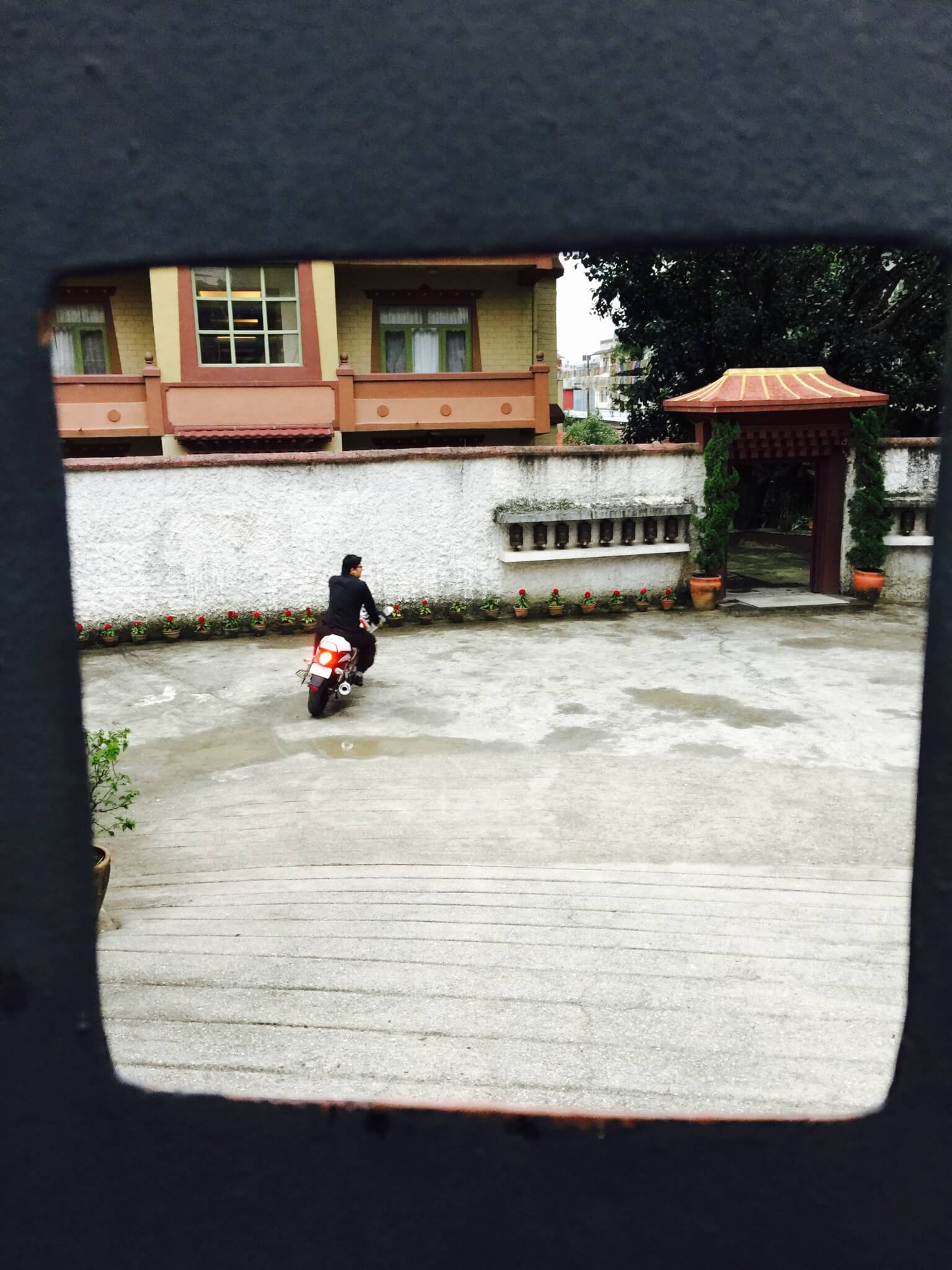
Once being welcomed by a friendly and handsome porter and shown around, we explored its surroundings.
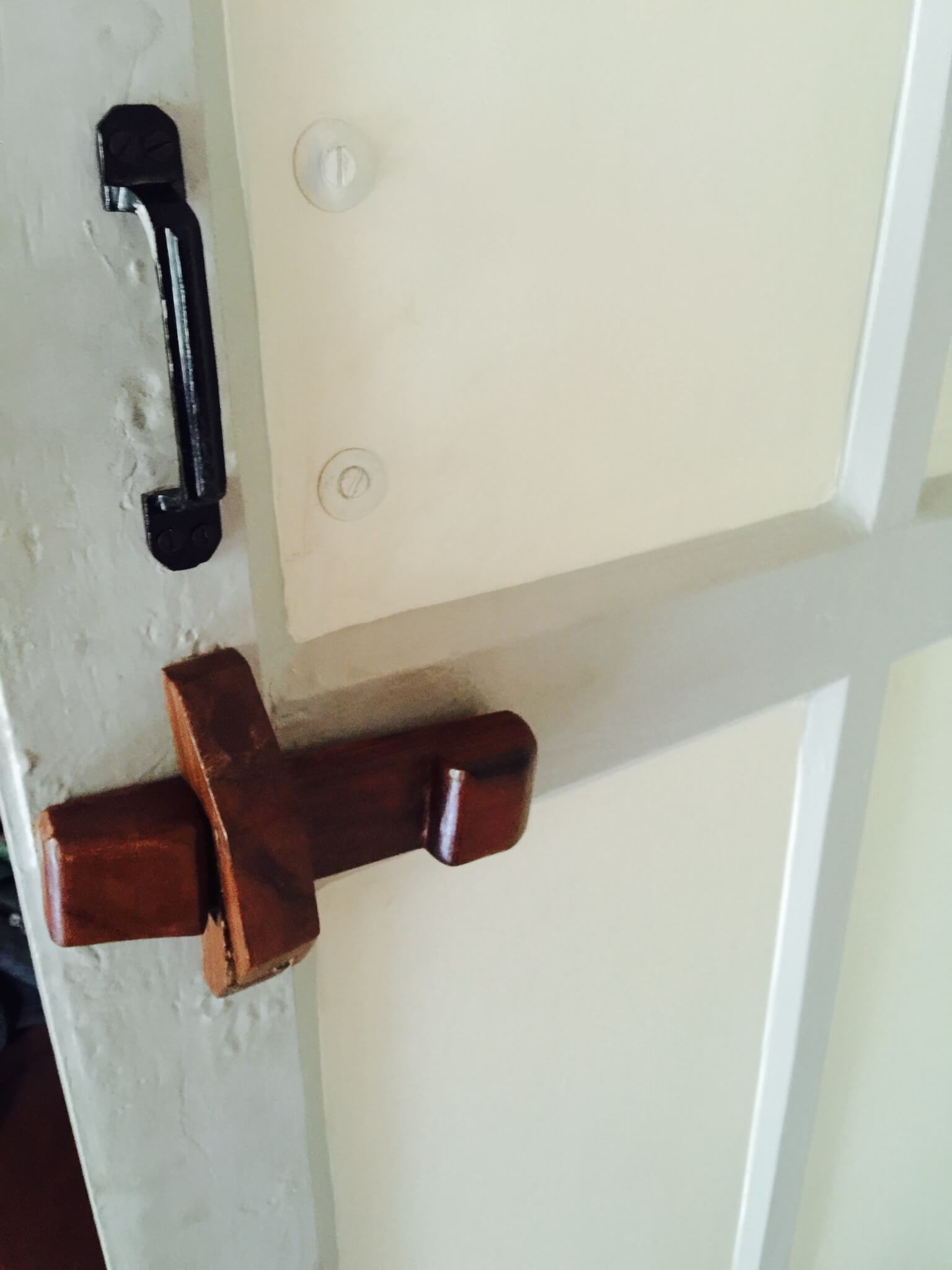
A modest and elegant room that we stayed in, full of local features from Tibet: dark wood door handles, notebooks from recycled paper, a whimsical fairy-tale key like from an Alice-in-Wonderland book. Even a traditional musical instrument was there.
Then we had some food which was ordered by Pavel via phone as we arrived. Apparently restaurants close early in Kathmandu, and by 9:30pm we had a tray with local traditional food delivered to our room. It was yummy: a selection of battered & fried local vegetables, fresh yak cheese fingers, accompanied by mint tea, a local desert (similar to Khvorost in Russia) and a bowl of fruit.
We looked at our clothes, checked what we needed to buy the following day for trekking, and went for a walk.
The walk was amazing. A quiet part of Kathmandu with monasteries and traditional houses with no people around. It was the first place I’ve been in Asia where at 11pm no people were on the streets and we liked it a lot. It had this mysterious feeling of a vibrant city that sleeps.
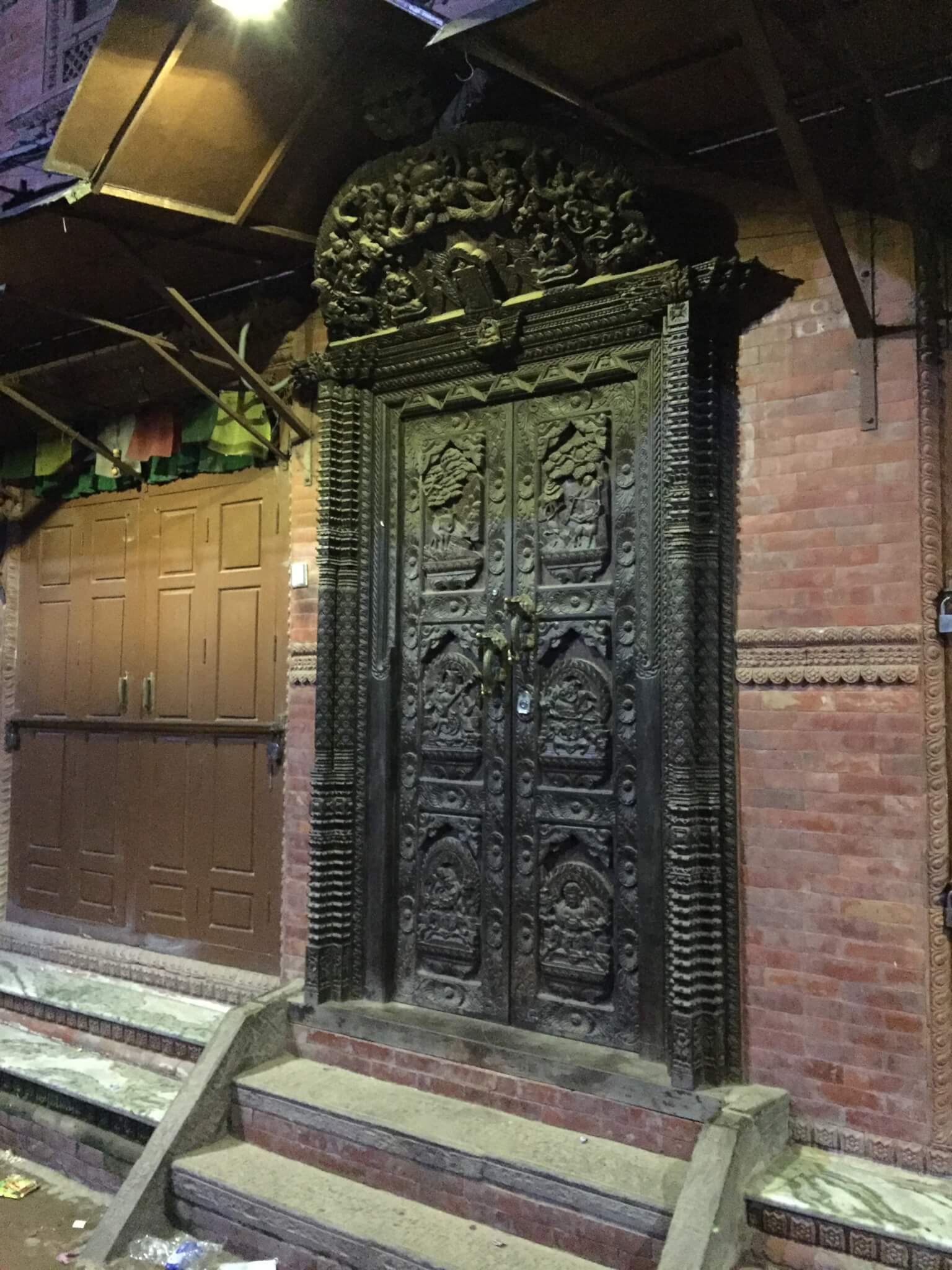
After coming back to Shambaling, we fell asleep tired and happy.
DAY 2, 21st Aug, 2016
“Relaxation day before trekking”
After waking up, meditating, stretching and having a nice breakfast: fresh fruit salad, Massala omelet and milk tea, we went for a walk in town to take pictures, withdraw local money and get some clothes to be able to spend some time in monasteries and holy places.
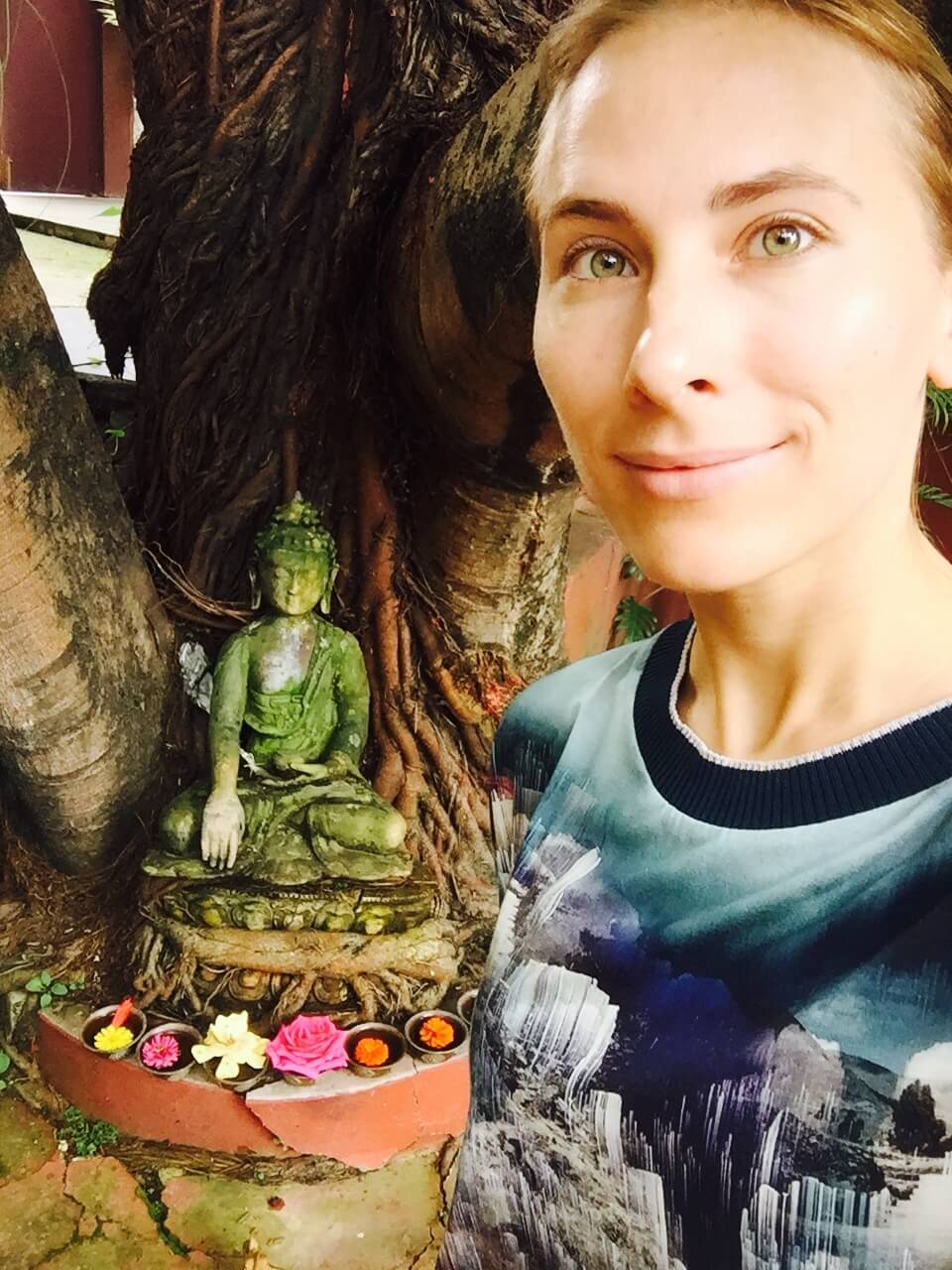
I didn’t bring skirts with me, so I bought cute cotton skirty-trousers that felt nice and comfy. To be able to try it on, a shop owner advised that he would go out and turn his back protecting me from onlookers, so I could use the space in the middle to change clothes. So I did. After haggling a bit for a good price, we got two of those skirty-trousers and left.
Looking at people working in those small shops, who most of the day stay there waiting for someone to buy their produce, made me think about two different worlds: developed and developing. We were discussing having a massage or going for lunch, whereas others live earning from 1$ to 5$ per day. That is reality for many people and some of us take our life for granted (that is me!), conditions we live in and opportunities we have.
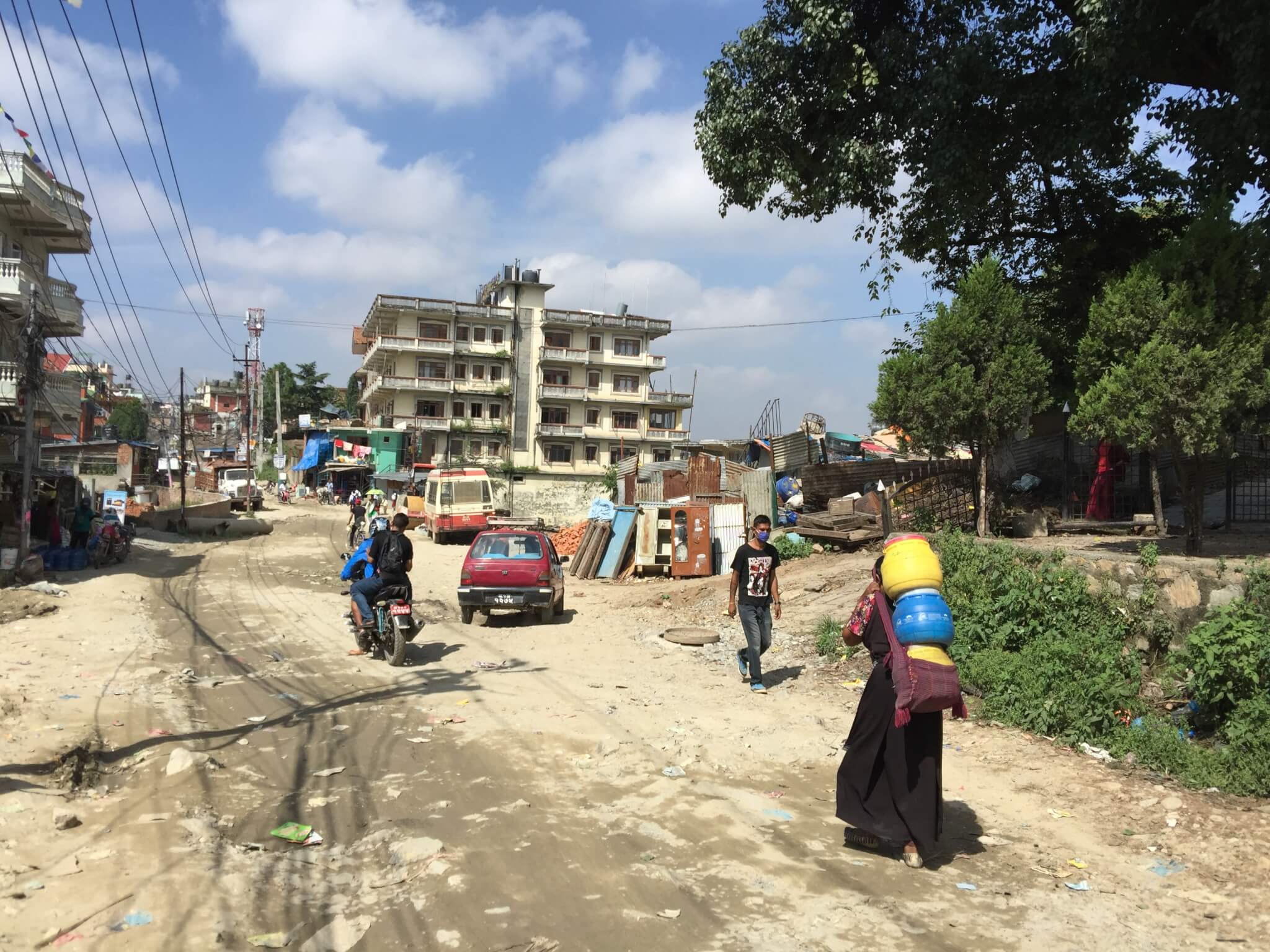
We headed towards the centre of Kathmandu, visited a couple of monasteries, saw monks and nuns, people praying & people selling local produce.
I particularly liked the herbs and spices stalls. The smell was so familiar and natural. They mixed fresh pine tree cones, small branches and leaves together with fresh little splinters, grated and put into a large sack, for its aroma to spread for meters attracting locals and tourists like myself, to buy the mix. I didn’t just want to smell, I wanted to eat it. It was one of the most beautiful combinations of smells I’ve tried. It reminded me of a Siberian village day when we went out to cut wood and collect grass and pine branches for banya (Russian sauna).

Walking around I was amazed how habitually chaotically busy this place was. And those electricity cables… they were everywhere. Above us, beside us, next to us. 
Around one of the biggest Stuppas (monument with a Buddha on top of it), we could see Tibetan grannies selling jewellery, young Nepalese girls selling local natural designer clothes & bags, Himalayan salts and stones, book shops and CDs of Indian music and chanting, and lots of other stuff. I looked for colours, people in this place of the world wear a lot more colours than in Europe. It looked so vibrant and full of creativity. Even old women were dressed in a rainbow-like skirts and scarfs, creating a wonderful background for a picture. Violet, pink, purple, blue, red, green, yellow. All bright and catchy colours uplifting the mood and attracting attention.
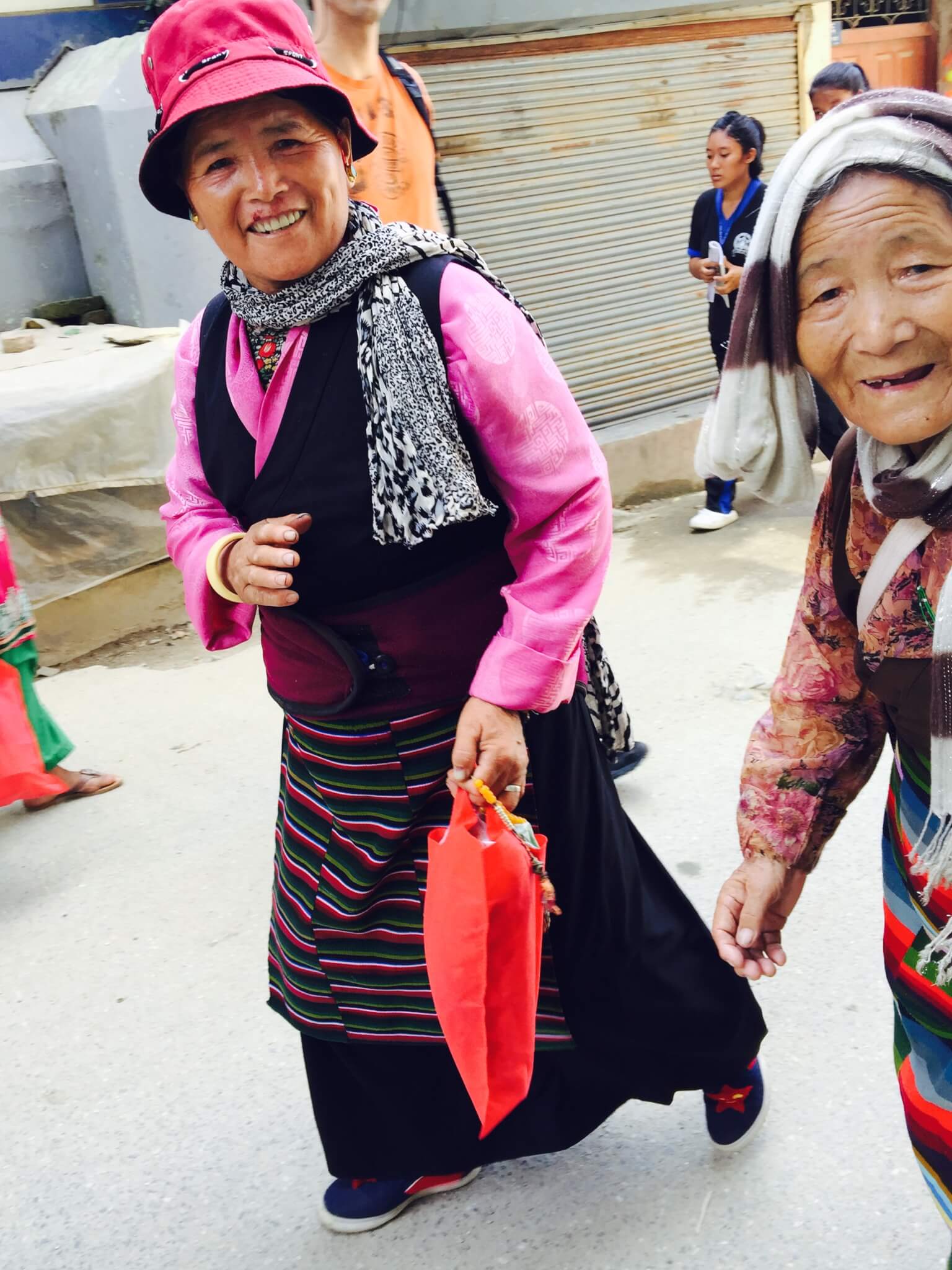
A bunch of rickshaws, small rundown busses and people carrying food were mingling together in the middle of a busy road beeping and making their way back and forth along the street. I stood there for an hour while my companions were sorting phone cards, power-banks for gadgets, picture-taking, money-withdrawals, calling the banks that had tried to prevent fraud and blocked cards being used in Nepal.
I just stood there and observed people. And I imagined what it was like for them to live here. I imagined myself living here as a kid. What a different life it would have been. On one hand, I felt grateful for where I had been born, for a ‘genetic lottery’, for opportunities I was given by my parents, for the education I had had and for all possibilities I had had to travel and see such places. On the other hand, I felt sad and angry for the unfairness of the world, for the lack of opportunities for kids living in such poverty and for not being able to get good a education or travel, for their families being so poor, for the lack of books, good roads, good food, good water and air. I wanted to help and wanted to find a way to do that.

We faced a way of life people have been experiencing for centuries. And maybe they are happy the way they are. I hope so. Because thinking about the majority of the world living in such conditions or even worse conditions, like in Bangladesh and parts of India, there must be a reason and I hope we can help each other to bring more balance to the world, more peace and create less violence and reduce unfairness. Education and health. Only if these two things were provided to everyone, what kind of a world would it be? How more beautiful our connections would have been and how enriched would we all feel? I wondered.
Looking in people’s faces, I tried to guess their thoughts, read their moods and troubles or joys they were thinking about. Some men looked austere and they were carrying heavy loads with water and fruit & veg. Women looked more relaxed even when they carried their children on their backs. Generally I found people were more relaxed than in Europe. Even while driving and appearing to rush, they were peaceful and relaxed. Something of a rare nature in the chaos it was on the road.

It was fascinating. I took so many pictures of local people as they were quite different to people I normally meet in Europe. It was like being in a different universe. People were busy with their own preoccupations, not staring at you, but busy with their own politics.

Ah, the politics, we learnt that in Nepal alone there are supposedly 11 communist parties. That says a lot about the country and how busy they must be discussing the political nuances, to create 11 parties. Where else in the world can you find this?

I had mixed feelings about Kathmandu. I liked it and didn’t like it at the same time. Our guide Pavel said it was his favourite city in the world. He has lived here for a few years and travelled a lot, so I listened to find out more about that place.
I looked forward to coming back after trekking to Kathmandu and exploring it further. I was sure there were hidden gems to uncover.

While our guide went sorting out the permits for upper Mustang, we went back to our hotel for a nap. After taking a shower, having a good sleep and eating local apples with small pomegranates, we did a good session of exercise and read teachings of Buddha, a book that was in our hotel for visitors. Quite a nice read. I learnt that everyone is a bit of a Buddhist in their heart as the most important virtue of Buddhism is loving-kindness and when people apply this virtue to their life, they become happier and become closer to the truth.

For an evening programme we went to supposedly one of the best vegan places in Kathmandu. OR2K restaurant. It was an Israeli restaurant with Nepali food that we truly enjoyed it. Veggie dumplings called ‘momo’, lentil soup with naan and raw veggies with a mushroom & veggie curry, yak cheese sticks with tomato dip and a boiled egg, mint lemonade and most interesting, a fresh tomato juice. It was the first time I had a freshly squeezed tomato juice. I always thought it was red, but actually it was pink and a little bit frothy. I liked it though.
Afterwards we got a small and nice backpack for myself, hats, gloves, a sleeping bag, wind-proof trousers, head-torch light, buffs (scarfs) and other stuff that added to our collection of things that we had prepared for the trip: the essentials like a water-filtering tube, survival kits, mountain sticks for walking, warm clothes and a bit of healthy food like dried fruit, peanut butter, mix nuts and water.
We also passed a local book shop where we wanted to buy a book about Mustang, and Pavel advised to get Michel Peissel: Mustang A lost Tibetan Kingdom. Michel Peissel was one of the first foreigners who reached Upper Mustang and documented that journey in his book. We were planning to follow his route so I was eager to learn his own impressions as we went along.
Afterwards we went to a city center square in the rain. Filled with people praying to scary saints masks, a ruined part of Kathmandu after an earthquake was hard to watch. Although it was dark, we could see the relics of what was once a magnificent site with temples and pagodas.
The day was crowned by having a massage in a local spa and visiting a bar with live rock music, where I enjoyed a Bailey’s on the rocks.
That was the happy end of day 2 of the trip. We returned back home in our beautiful Shambaling hotel and rested until 5:50am.

DAY 3, 22nd Aug, 2016
“We thought the trekking had begun”
I woke up to pack the things carefully that we needed for the trekking part of our trip and was surprised how long it took me to do that. I had to make a conscious choice for every top and every pair of socks as everything had to be carried on someone’s back for the next fortnight.
After having a nice breakfast and reading my book, we started our journey to Kathmandu airport with a hope to fly to Jomson via Pokhara.
Once we got to the local airport and checked in, we were allowed to board a small plane. I was ready for a bumpy road but surprisingly it was smooth and quick. 25 minutes to be exact. One of the most impressive things was that during this very short flight we were served with candies and cotton-wool for our ears, drink and a snack and a lot of smiles from the Nepali cabin crew.
After arriving and picking up our bags we were told that the next flight that we were supposed to take from Pokhara to Jomsom was cancelled due to high winds.
We decided to take advantage of the time available and stay at Pavel’s friends’ guest-house which they extended over the last couple of years to be one of the nicest hostels in town. A very friendly host, an owner welcomed us with her broad smile, ‘Namaste’ greeting and her son showed us their new rooms, and in one of them we decided to stay.
A spacious room with a fan, balcony, tv, table with a phone, a toilet with a shower with no curtain but slippers given to avoid the wet floor. Clean and simple.
After leaving our stuff we went for a walk and lunch in the centre of Pokhara. The centre is in fact the main road around a lake surrounded by restaurants, little shops and spas. And there were hundreds of spas. The largest concentration of spas I have ever seen.
Hot and humid, we quickly got tired and hid away in one of the cafes for a glass of lemonade.
Slightly refreshed, we moved back onto the street and continued our walk along the stalls.
Alex enjoyed haggling for a large backpack rain cover, a pair of trousers and large-brimmed-hats. Meanwhile, I observed people passing by. Dressed in colourful traditional clothes, they were busy with their activities. A few tourists passed by and I heard them speaking English, French and Norwegian.
For lunch we went to a popular Moondance café where we had veg pakoda, spinach paneer (local cheese in a spinach curry), yak cheese pizza, and a beetroot-apple-pomegranate-cashew-onion salad. All that with juice freshly squeezed from mango, pineapple, papaya and watermelon. Yummy.
Equipped with water we strolled along the road around the lake. The lake was a large green reservoir filled with small boats, lake flowers and lakeweeds. Unfortunately, the site was not inviting for the eye. Plastic rubbish was thrown everywhere and I was put off by the look of it despite the beauty of mountains and trees around.

Tired of the heat and walking we headed back to our guest-house to rest, to read and prepare for our journey the following day.
Just before approaching our stay, there was a reflexology parlor. Local Nepali people explained that it was not just reflexology but a medical sukushindo method, a famous Japanese art of diagnosing health problems from touching the foot and healing by massaging it using a special technique. I was very curious. Firstly, it was Japanese. And as a lover of Japanese culture I was instinctively attracted. Secondly, it was something I longed for after walking for the whole day and seeing the signs of spas on the way, I really wanted some relaxation and rejuvenation.
Relaxation it wasn’t. Making her way through my feet, a young lady applied a lot of strength and intricate movements to get to the deepest parts of my foot sole, massaging and applying pressure to apparently special points of stress release. Similar to reflexology but different in application and movements. Rotating and using nails and fingers she found a couple of slightly painful points and by massaging them, released the tension. They also told me that this method was popular with locals as well as foreigners. One French woman who came to Nepal and suffered from headaches, had only three sessions and her headaches disappeared. She then advised her sister to travel to Nepal from France, to see this young doctor, a student of a sukoshindo master, who studied with a creator of sukoshindo in Hokkaido, Japan. That woman had eczema and after 4 sessions almost everything was gone (apparently 90%).
Despite the fact that it was at times uncomfortable and painful, I really enjoyed it and afterwards I felt a sense of relieve and lightness. They advised me to drink a lot of water and go to the toilet when I wanted to and not to wait for too long, cause my bladder was a bit swollen, according to my feet (lol).
While my foot was being diagnosed I had a good chat with the local Nepali owner and his sister about the situation after the earthquake and local food. Got a couple of ideas for dinner and learnt ‘Daniye bat’ as thank you and ‘Tapai lai kastocha’ – how are you.
Off I went to try my Nepali knowledge in a local restaurant where we had organic green salad with apples and carrots, home-made pasta with pesto and mint lemonade with banana for a desert.
Full, tired and happy we returned back home and I slept soundly until 5:30am.
DAY 4, 23rd Aug, 2016
“Catching a 15-minutes flight took 15 hours”
Woke up at 5:30 to pack to have a shower and some breakfast before heading to the airport for a flight to Jomsom. So we hoped. Due to a local Hindu celebration we had to wait another day to fly for 15 minutes to Jomsom. Alternatively we could take cars and travel for 8 hours on a bumpy road full of dust. And not even in one car. We would have to change cars as on a road to Jomsom there are syndicates who allow travelling only in their own cars.
A-15 minute flight or a 8-hour-bumpy-road-ride? We made a decision to wait for one more day.
This was all despite the fact that our guide and porter both told us we should take a car route. They phoned the airline company and confirmed there would be no flight for another two days.
Alex insisted we wait for an airline representative and try to fly that morning. I was really amazed when we were told that there is a possibility for us to fly. In my head we were already driving for 8 hours. Mentally I was prepared but I felt relieved when we found that we could actually fly.
Our porter Tanzen and Pavel stayed in Pokhara whereas we took a tiny airplane to Jomsom, a city at the base camp of a lower Mustang.
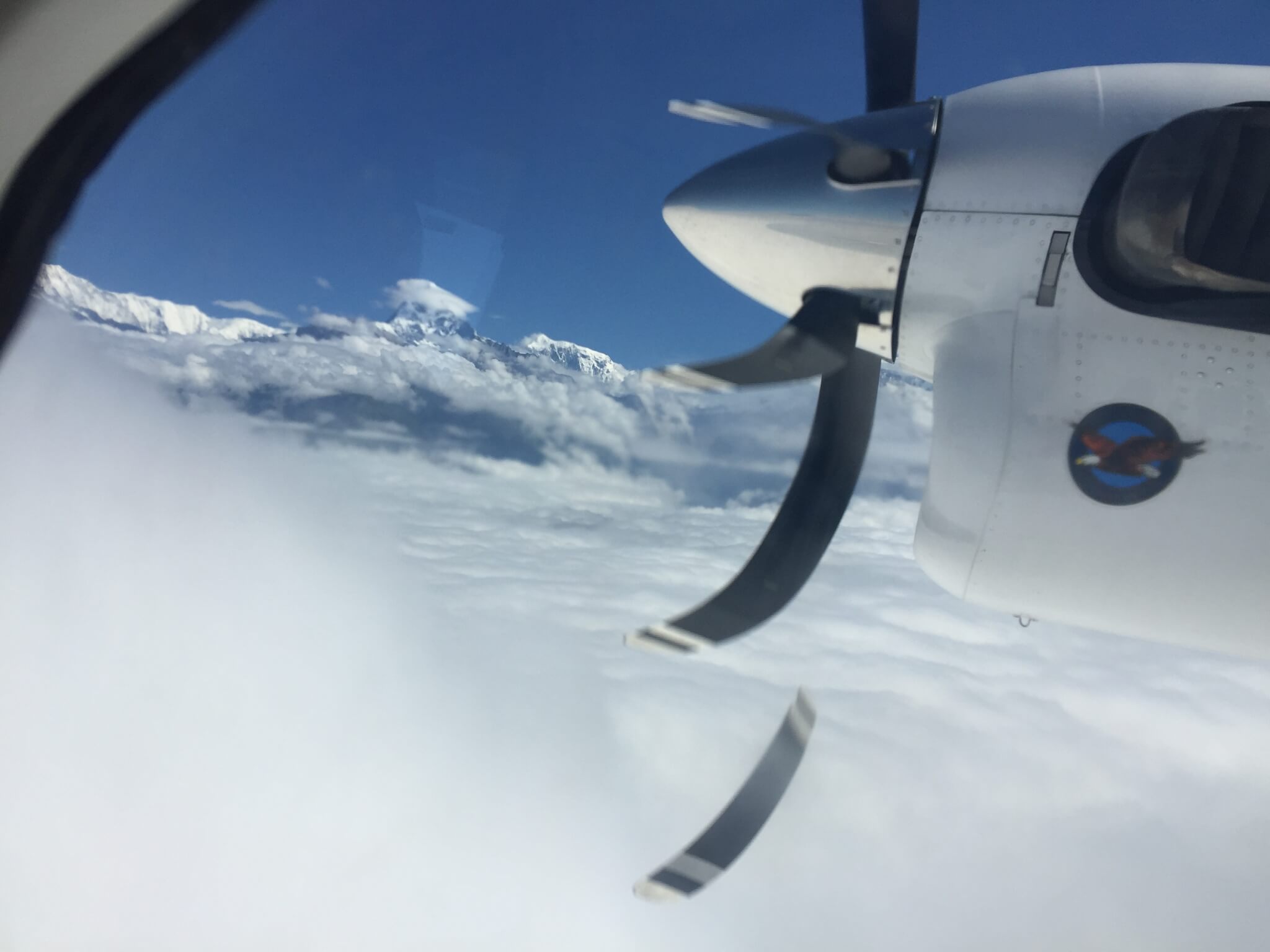
When we got there, a short, dark-skinned man with a hat and wind-proof coat met us together with even darker-skin man, also wearing a hat and warm trousers as well as The North Face coat. They travelled all the way from Kathmandu to Jomsom by bus to help us with our bags. This was Sange, a nephew of Tanzen and his friend, both travelled for two days whereas it only takes 25 minutes by plane. All because of mountains and long-winded roads. Flight was only for foreigners and rather rich people.
Happy to have help with our heavy backpacks we came out of a tiny airport after signing in a book that we arrived, leaving our passport number and number of days we are planning to stay in Mustang. Five minutes up the road we entered our first guest-house called Tilicho with a friendly host greeting us and welcoming to go to the first floor to wait while they sort out other guests leaving. It was a busy place with a lot of different foreigners coming from all over the world. A place looked like one of those that show in old movies, full of small objects, different colour lamps and random stickers from around the world on windows, creating a rather homely atmosphere of a local hostel. Nepali people gathered downstairs around a TV set watching some tv series and younger members of the family were cleaning the place and preparing food for cooking.
Just five minutes after we arrived, a group of 12 Spaniards appeared in the yard and a lot of luggage following them carried by porters. They did also a two-week trekking with their guide and a cook (apparently a very good one) sleeping in tents hence the amount of luggage on them.
After a quick chat and cheering they left into their rooms and we had a nice lunch from a local Thakali cuisine. I ordered veggie cheese momo & dhalbat with eggs, which I shared with Alex with a glass of local Everest beer.
A very handy thing that I discovered during the trip was that we liked and ordered the same food with Alex so it was easier to share.
After a good food intake we went inside our room which was a four by four meter two-single beds room with a bathroom. Although mattresses had sheets, we still used our sleeping bags for sleeping as we had no covers there. And nothing in the bathroom apart from a hole in a ground, sink and a shower head. The good thing that we had hot water.
A nap turned to a proper four-hour sleep. Alex had worked in the last two nights before we arrived here so he was tired and caught up on his sleep. While I read my book and meditated I realized that I missed Nikolai & Dimitri. I phoned my mum to talk to them a little bit and catch up on what’s going on with them. Nikolai saw me and said that he wants to go to Nepal as well whereas Dimitri told him that it’s too difficult for him to walk for the whole day and there are places with no electricity and water. It was too funny to hear this from him. A little boy speaking like an adult with his little brother.
I was woken up by a knock on our door. It was Sange prompting us to go out as we had promised to be out two hours ago. It took us another 15 minutes to get ready for our first trek. Alex packed all the necessities, even a survival kit in his backpack, we got our hats, sunglasses, put sunblock on our face, neck and ears, took our wind jackets and headed towards the mountains.

A windy and dusty road led towards a connecting city of Kagbeni, a stop on our journey towards Upper Mustang. We decided to test-trek a bit to see how the road feels and on our way we met other travellers coming back from their journeys. Many of them were tired and sunburnt, but most of them happy confirming the trip was spectacular and worth doing.

That was a very positive start, enthusiastic and excited about the following days, we returned back to our camp. On our way we saw Sange who was having his dinner in a local café. He invited us for a cup of tea and we entered a home-like low ceiling building with wooden tables and benches painted in dark red and brown colours. A host, short and full-bodied Nepali woman served us two cups of milk tea and we were invited to taste home-made momos.
It took us just another hour to get hungry and we ordered dahl bhat to feel full of energy again.

Our preparation gear was set for tomorrow awaiting for Tanzen and Pavel to arrive with an early flight.
DAY 5, 24th Aug, 2016
“Our First Challenge”
At 5am I woke up from a strange dream. I felt I missed Nikolai. In order to remember my dream I woke up Alex to tell him. He carefully listened to my weird story. In my dream I saw Julia Roberts (I think it was because on the way to Kathmandu I saw ‘Money Monster’ film with her) and Robyn Williams who I welcomed to my place in Krasnoyarsk where I used to live when I was a child, on Schorsa Street. I was getting ready for a long time choosing which clothes to wear as I was planning to take Julia and Robyn to my school (have no idea why!) and asked my mum for a car key. On our way out I realized that the car was of a sport nature and couldn’t fit all the passengers including two kids in it. Then I thought kids may sit on their lap. No, that wouldn’t work. We got out of the building and a huge people carrier stopped in front of the entrance. “You can comfortably go to school in this car’ – I said to my celebrity guests. Meanwhile I realized I took a wrong car key and went back home. As soon as I got the right key, I got out and saw a lot of people gathered in groups. I couldn’t find Nikolai. I looked for him and worried where he could be. “Mama” – I heard from one of the groups. There he was, with no shoes and I had no idea why he was there with some random and some familiar people. “Where is Dimitri?” – I asked him. “He is here” – answered Nikolai but I couldn’t see Dimitri anywhere. We turned around the corner I saw Dimitri sitting on a bench next to the building just waiting for us.
What a strange dream. After telling Alex we decided to sleep a bit more.
We were suddenly woken up by a strong knock on our door. Alex stood up first to open it. It was Sange telling us we should wake up and have our breakfast before a long day ahead. It was 6:30am.
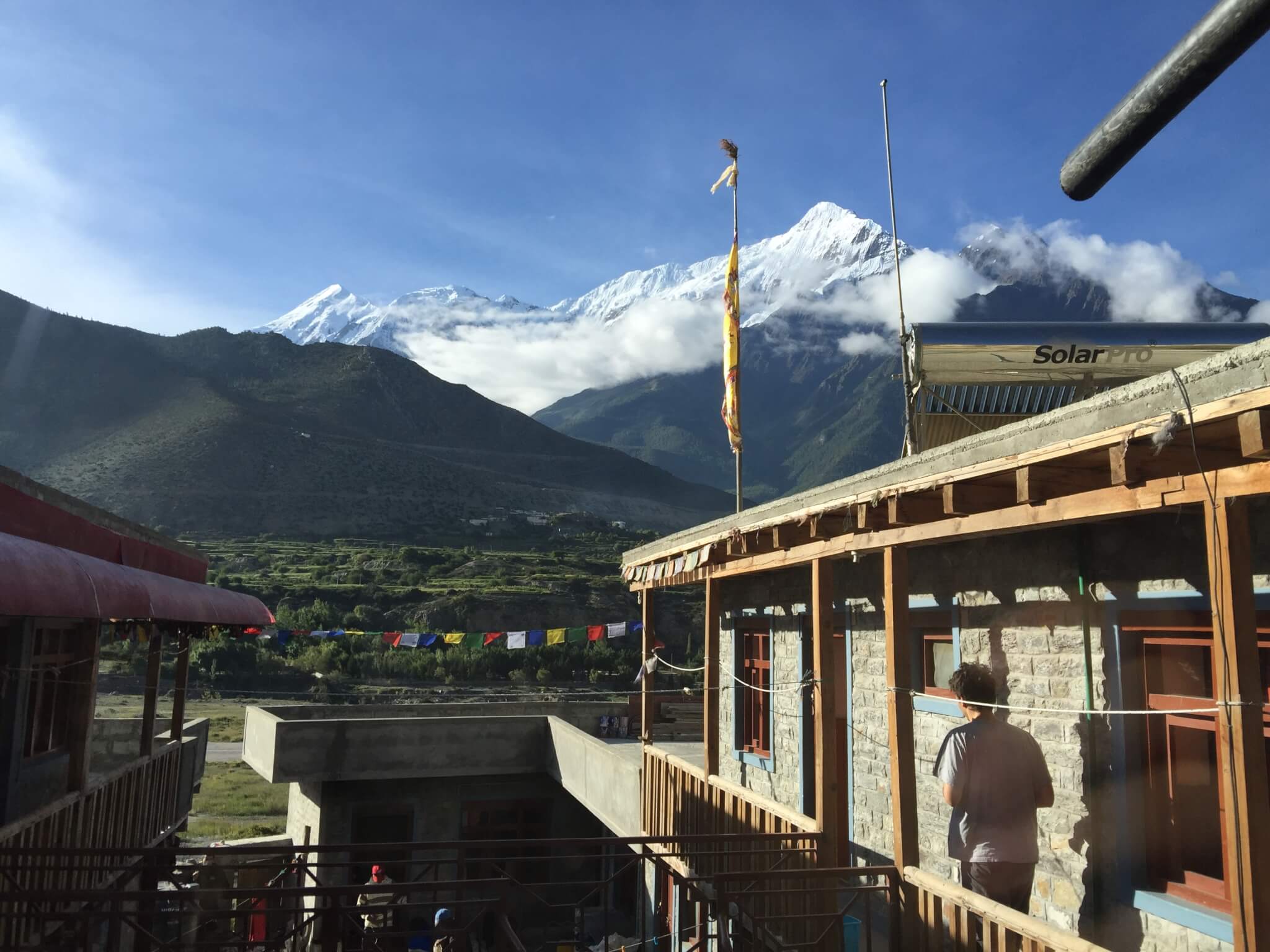
Pavel and Tanzen arrived with the first flight from Pokhara and now we were all together ready to head off to the secret land of Lo Mantang.
Taking our mountain sticks, putting sun cream, wearing hats with wide edges, we stood out into the sun and new adventures. The proper trip has begun.
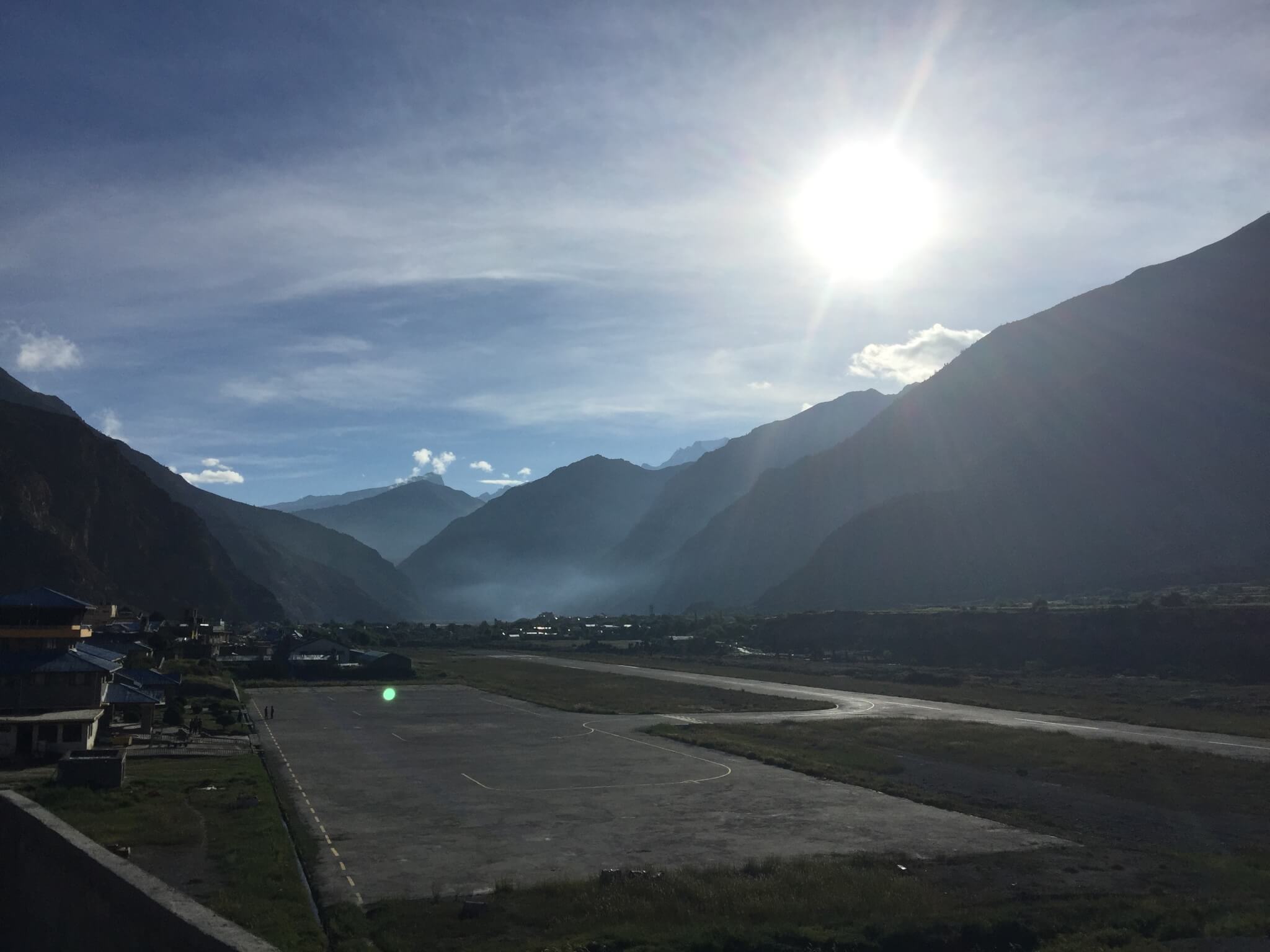
It was my first long trekking experience. We started by walking around 40 minutes towards the first station of jeeps to get on them to drive to Kagbeni. From there onwards we were planning to walk up the mountains for two weeks.
After getting inside a jeep, I thought it would be a smooth & quick road to Kagbeni. But smooth it wasn’t whatsoever. I was scared that we could either slide downhill or roll over as a very old model of the jeep we were on, drove us over streams and dusty turns, uphill and downhill until we arrived in a small town of our little journey.

Greeted by two little girls, we got out from the jeep and started our ascend. Tanzen led the way as he was a Nepalese guide who we were supposed to have despite the fact that we had Pavel as our guide. That was part of a national requirement for a getting a permit to the Upper Mustang.

The road had magnificent views on ranges of mountains. Our aim for today was to get to Kagbeni on a way to Lo Mantang.

As we came downhill we had to cross a river. There was a large bridge but we had to go there for another 30 minutes. Instead, we decided to cross a river bare foot, despite my fear of being cold & wet. Tanzen took my boots with socks and with a help of mountain sticks we started crossing it. In my mind there was one thought: I didn’t take any second pair of clothes so I should be dry and warm. It was just a beginning of our trip and I didn’t want to spend the rest of days having a cold or flu.
Crossing the river was easier than I thought. I felt good reaching the other bank and sitting down to put my shoes. The feeling of freshness was amazing.
We walked and walked. It was a long trail but apparently the following day was the hardest one and we had to prepare for that psychologically and physically by adjusting to a higher latitude and the amount of walking.

Sun was up and shining bright. We all used a lot of sun cream to spread on our arms, face and a back of a neck especially, as these were the most likely places to get burned. Apparently if only you forget to put sun-cream for an hour, a high mountain sun is so strong that it burns the skin even a dark one. Hence my ridiculous hat.

In additional to the sun there was a lot of wind. At some point I had to be careful where to put my feet as gusts of wind were pushing my body side to side. Wind came with sand, so we were getting covered with sand all over. I hoped for a shower in our destination point to get all that dust away.
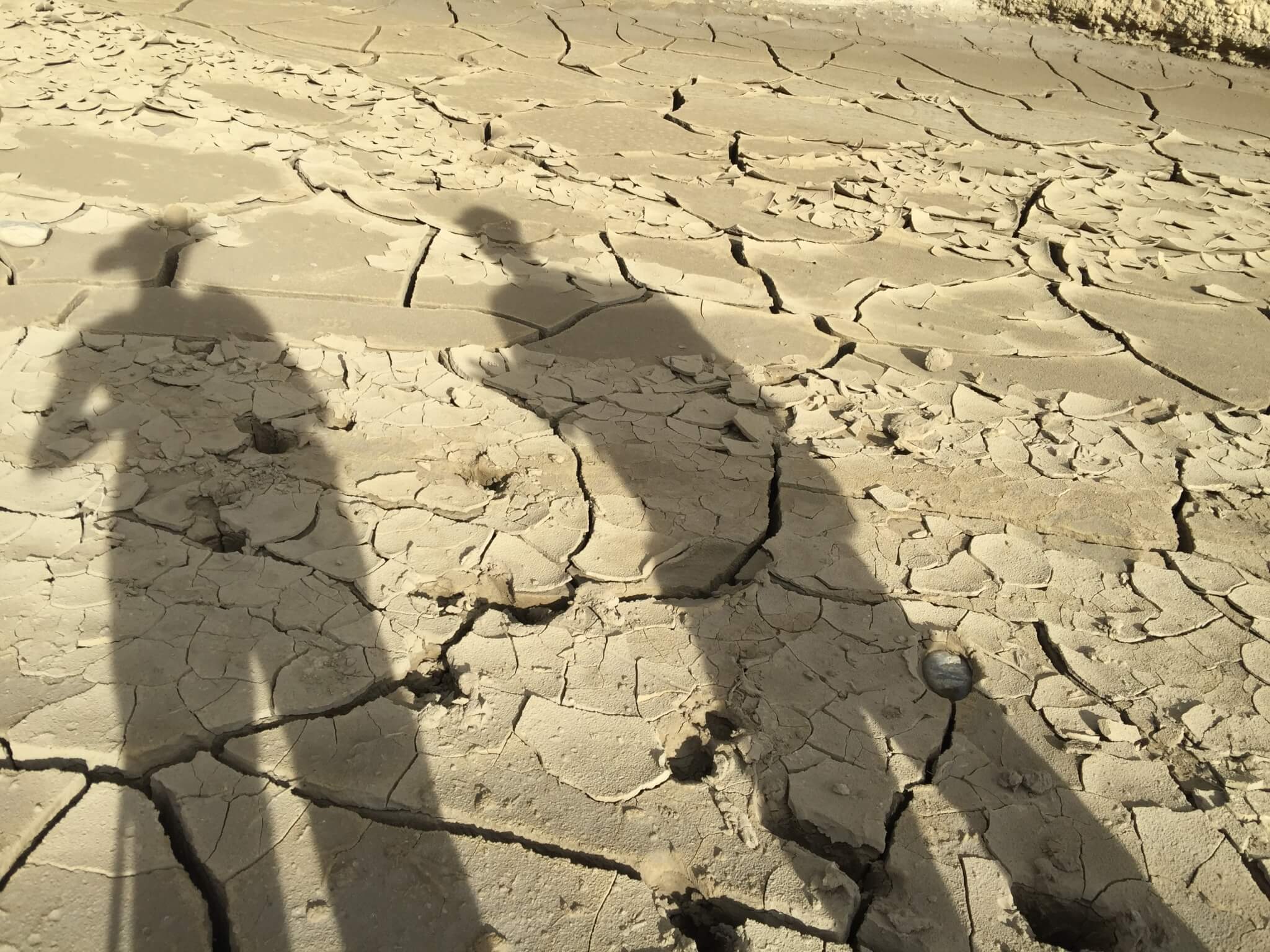
On our way to Kagbeni we stopped at Tombe for lunch in a traditional Tibetan restaurant. As I entered the place I faced a big place where hands and vegetables get washed. A toilet was around the corner and comprised of an old style toilet hole where you squat, and a bucket with water, for apparent reasons. Toilet paper was a luxury and had to be carried with you across all of this region. But a view from all the toilets was just incredible. Having no glass in a toilet window for ventilation purposes, one can enjoy a magnificent view of the mountains and a backyard of a village house, sometimes with animals or a view on other houses. Such a nice surprise despite the lack of European toilet comfort.
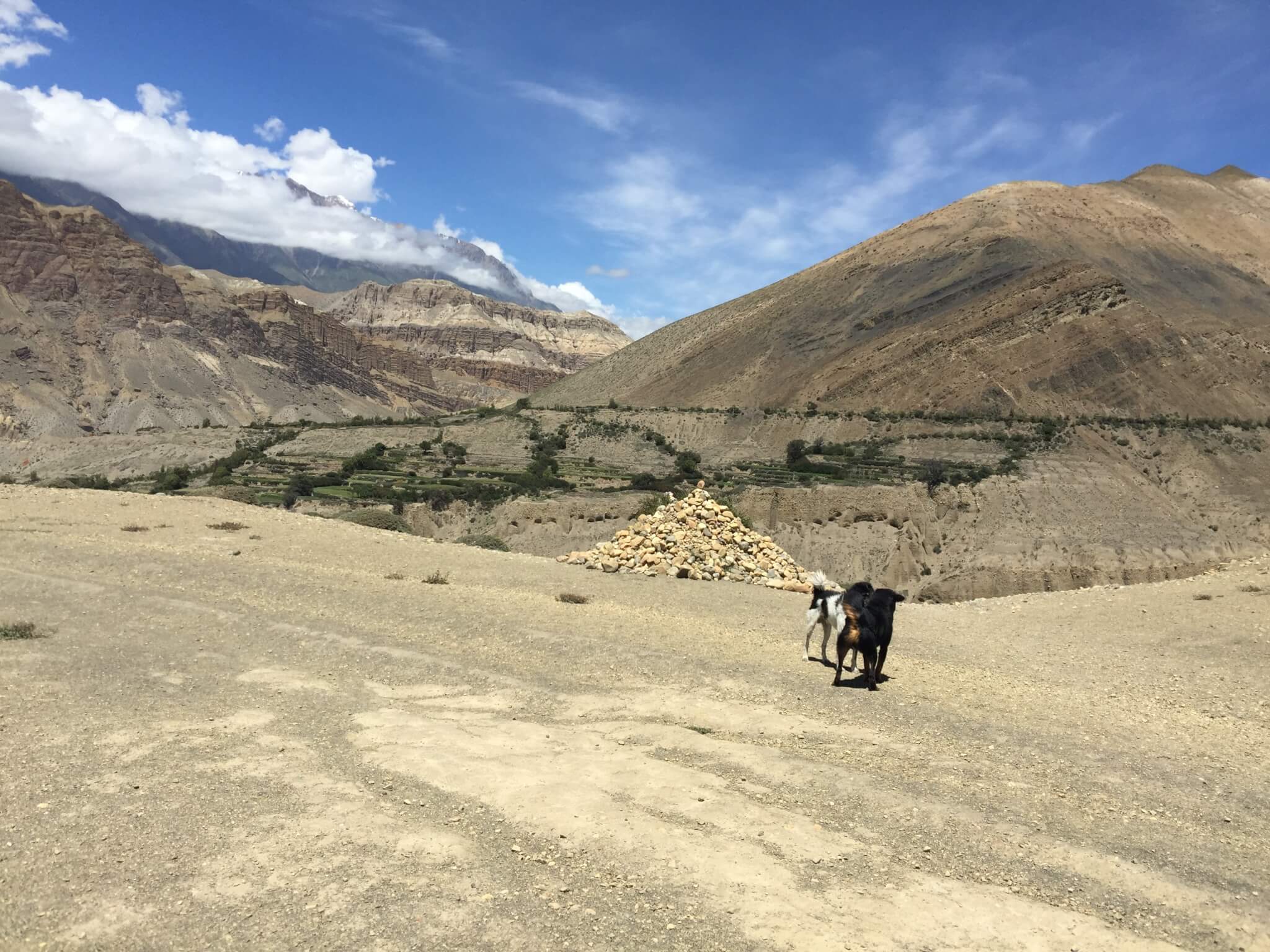
We saw a friendly woman who approached us and took our orders and disappeared into the kitchen.
I ordered a fresh vegetable soup and dal bat. Alex & Pavel also chose dal bat.
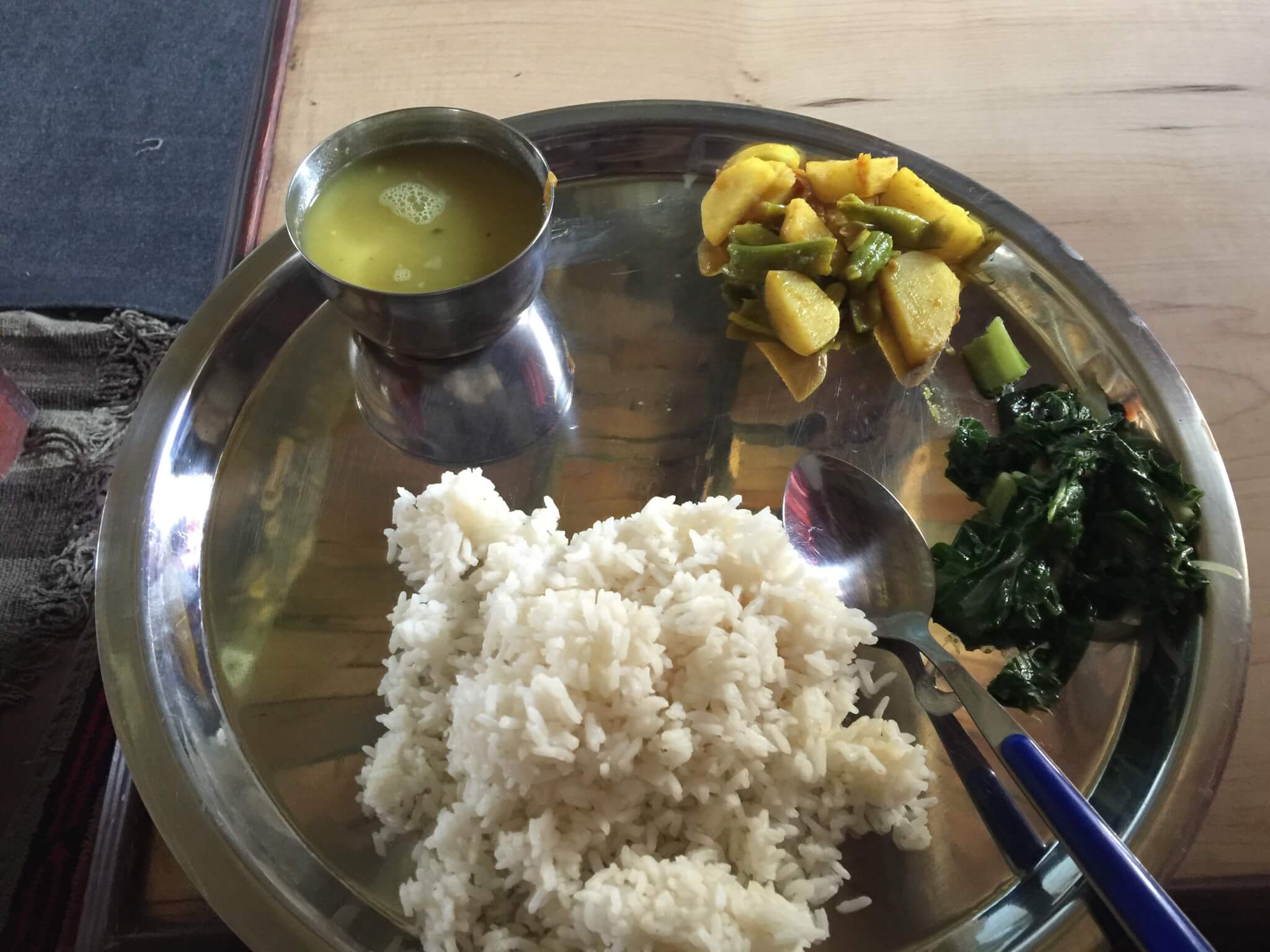
We took places at the back of the room where they had nice sofas and where I could rest a bit after a long trekking.
In front of us was an empty space and a a big carpet on the floor. A ceiling was typically made of wooden logs and in-between them branches and other material. Some rooms had a fabric cover, but mostly it was left natural. In a corner I saw an old television set covered with an embroidered towel. Apparently it was a popular gathering place for local monks who don’t have a television and prefer to catch up on a normal life of people and news.
We met a German couple in their 40s with a Nepalese German-speaking guide. All had a guide and a porter. A porter would carry two big backpacks and their own small backpack with a total average weight of 40 kg. And they were so fast and strong, overtaking the owners of belongings and reaching intermediate destinations beforehand.
While I struggled to move even my own body, porters carried 1.5 times their weight up the mountains and cheered us up.
For a snack we stopped at Chussang. A small village with a nice apple tree garden. I hoped for an apple crumble. We entered a small dining room with a traditional Tibetan style. Low sofas with carpets on them and low tables next to them. Attached to one of the wall was a cupboard full of Tibetan jewellery, utensils and musical instruments. I saw a nice Dalba and offered Alex to play it. Despite it being used, it sounded wonderful and exotic. Similar to drums a prolonged wooden large tube with animal skin on both sides and in a middle of them a circle made of tar, to create a different tonality while playing. After trying out Alex gave this little gem to Pavel as he spent 3 months in India learning how to play this thing each day for 6 hours. It sounded wonderfully and we all started adding a bit of our own beat to the rhythm. A Tibetan young woman appeared with a smile when she heard us creating a beat and Tanzen collected our orders. I wanted an apply pie and Alex chose an apple pudding. A window was open and I stared at ripe and beautiful apples hanging on the apple trees. Cheekily I asked Tanzen if we could try local apples at all and in a few minutes he brought a plate with 4 of them. While Alex and Pavel played their new toy I enjoyed a fresh and juicy apple. After trying to bargain for a good price and realizing that it was a triple one versus prices in Kathmandu, boys decided to try to use local tables as drums instead. Just for fun but the sound was as good if not better than Dalba. After a bit of fun we left the place as we still wanted to reach Kagbeni with the sun.

A trail was gorgeous. We went up and down the hills and across magnificent mountain ranges mainly along a large road in parallel to Kali Gadaki river finally arriving in Cheli tired and happy, after 6 hours of walking.
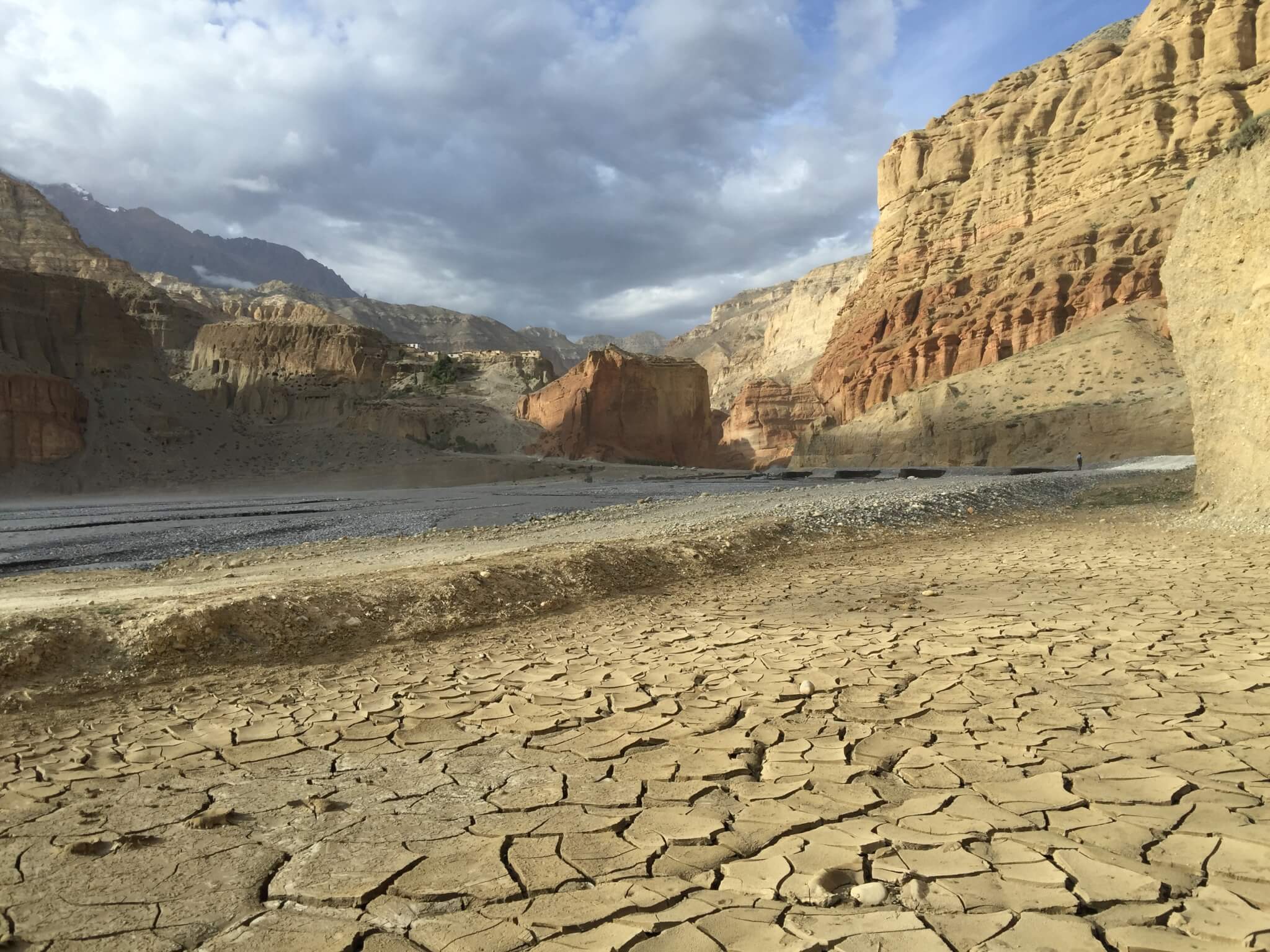
I longed for a shower. Supposedly it was hot. When I got to the bathroom (both a toilet and a bathroom was all for guests, I could only manage to get a cold water. My choices were: to get dressed, get out and potentially lose my queue for a shower to get hot water or to wash in cold water. I chose the latter.
For dinner we had Dal Bat. Apparently it is the very food that locals eat every day, twice a day. A composition of a lentil soup, rice, potato & green beans curry, steamed green veggies and some pickles. All on a big metal plate and each of these different parts having its own place. Lentil soup is supposed to be emptied on a pile of rice and eaten all together with other ingredients.
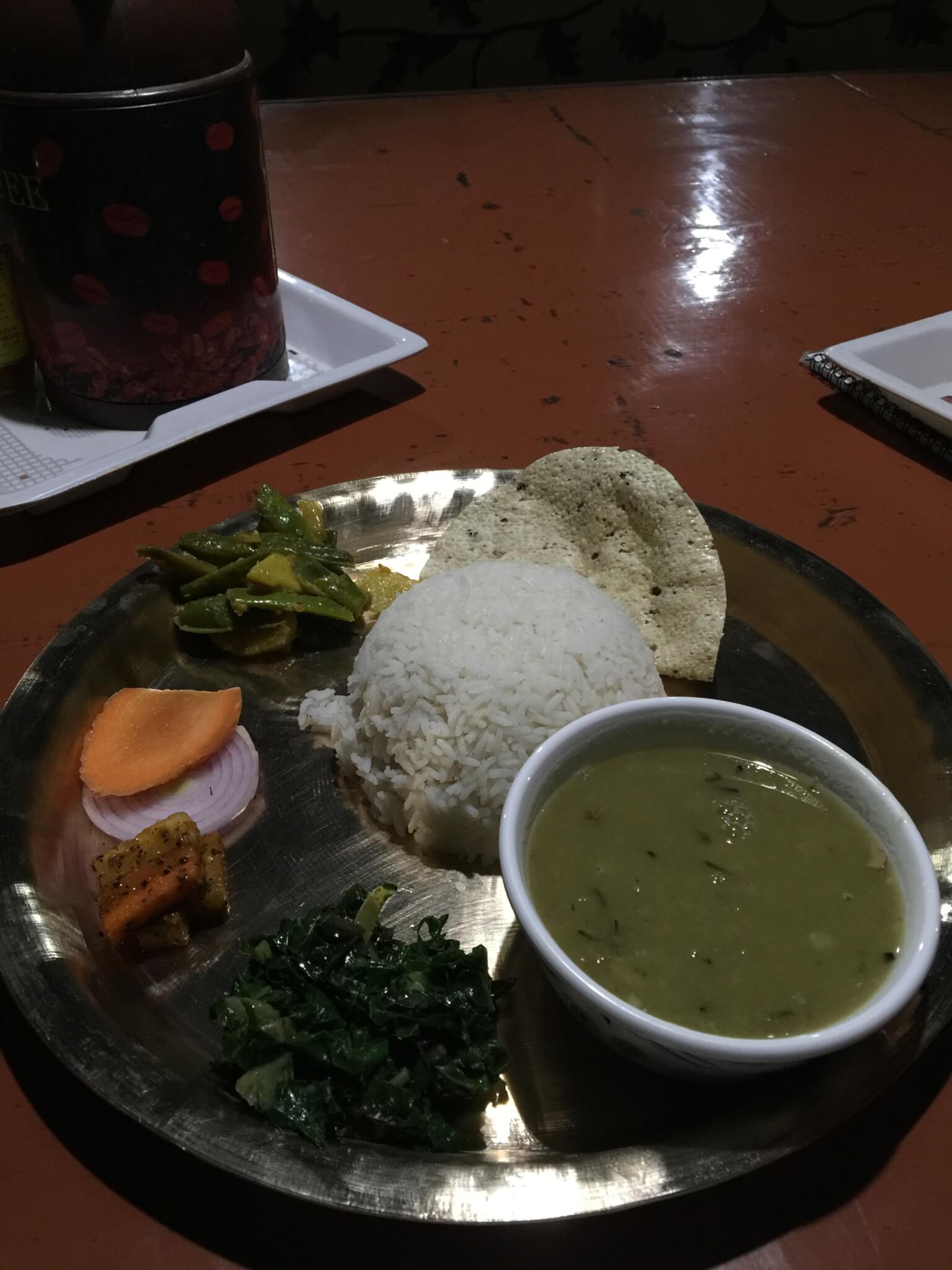
“Why is it so popular, this food? Why do locals eat it every day?” – I asked Tamzen. “Because if you buy something and after you feel hungry, you have to buy another dish. With Dal Bat you buy it once and then they add if you still feel hungry. It’s a local tradition. So with Dal Bat you are always full afterwards’. Indeed after a short while a friendly local hostess came with additional food to serve to those who ordered Dal Bat. And it was tasty!
We had no electricity even to charge our phones so I had to scribble my notes inside my notebook.
Having read the book and after chatting with Pavel and other travelers (we met a mother and a son from London and a couple from Germany, the ones who we met for lunch on the trek), we went to bed. Each in our own sleeping bag, with a hat and clothes on. In total silence.
DAY 6, 25th Aug, 2016
“Day of Horror”
We had an early start. At 5:30 we were already packing and having our breakfast at 6am. We ordered Tsampa, a barley porridge and buckwheat bread. We had peanut butter with us, so we used that on bread and asked for some honey for the porridge. To get some hot liquid to wake up we ordered Tibetan tea, which had salt and butter in it. All together it was a rather heavy combination but apparently exactly what we needed for today.
Sange has already left the guest-house with our large backpacks ahead of us, and after eating our breakfast we started our journey towards Geling. It was our ultimate destination for today. But we had a plan B, in case we couldn’t for some reason reach Geling. And as we found out, there were a lot of reasons.
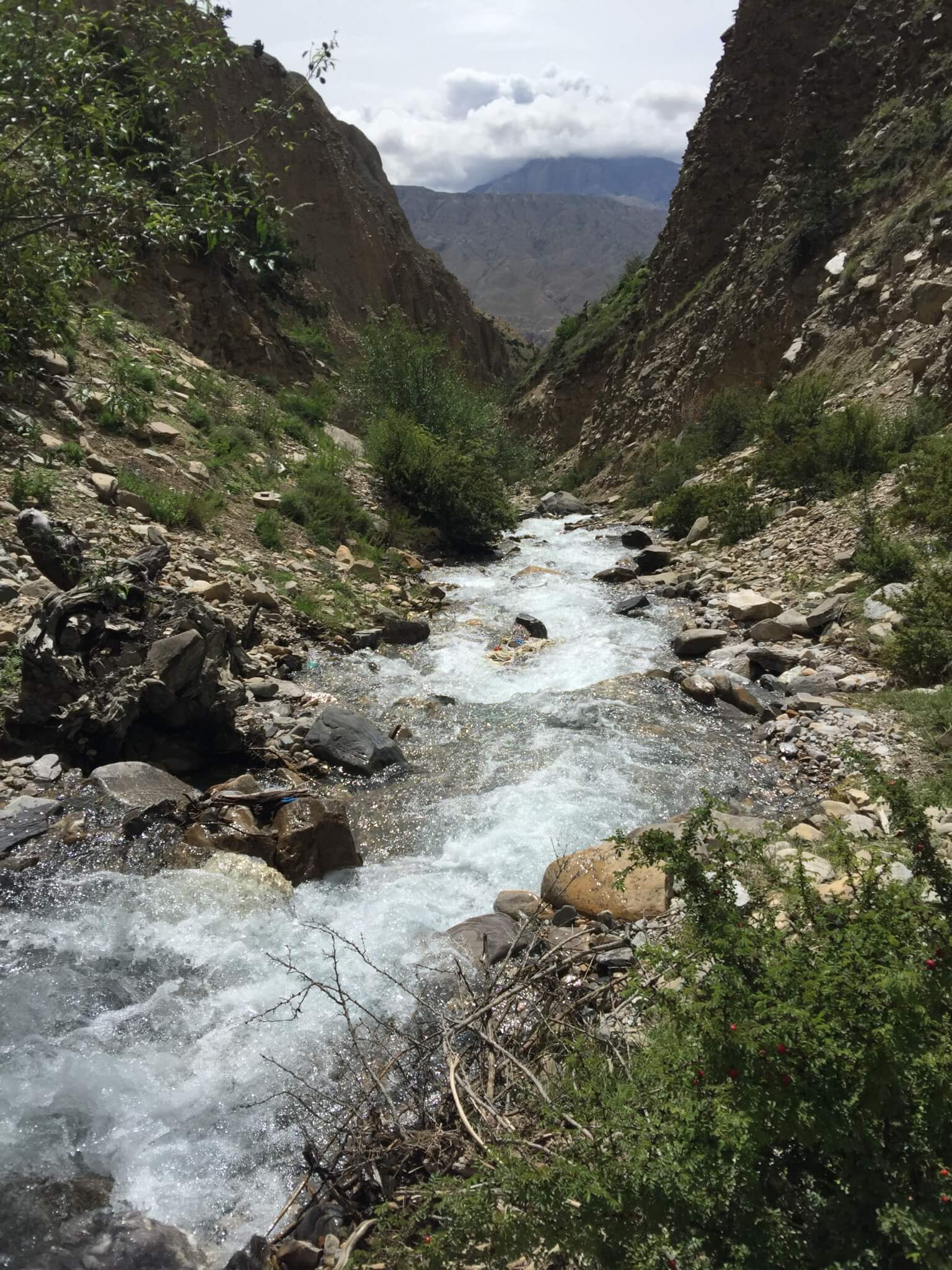
I had the most reasons to stop earlier. If only I was an experienced trekker or someone who has done trailing in mountains before, it would have been much easier. But it was my first trekking experience in my life and I didn’t realize how difficult it would be. The day before was wonderful and I thought that was the level of difficulty. But during the uphill, I got very tired.
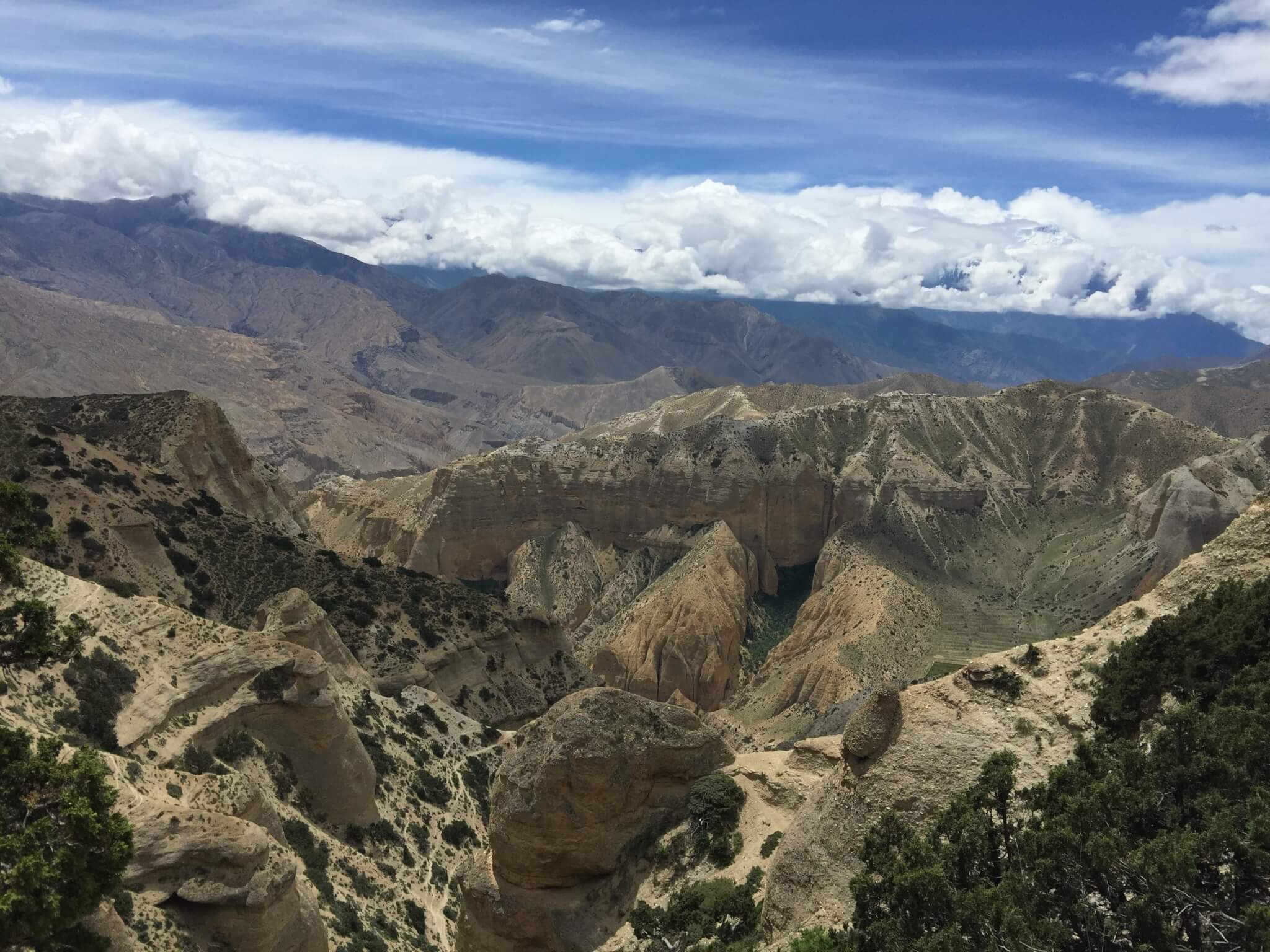
My legs started trembling, my head started hurting and I had a strange feeling of dizziness. Partly it was a change of latitude after we reached 3500 meter level, I could feel it even more. Around 4000 Alex and myself both had a strong headache and on top, I felt exhausted.
To add to the challenge was the trek itself. We went across the mountains along a walking narrow path. So narrow that at times, there was only a place for one foot to step on it, and those were my places of horror.
I didn’t realize until then how much I was afraid of heights. I felt shocked that I was doing such a crazy thing as climbing and walking such a dangerous path. What was the reason for doing that? I doubted I wanted to continue. I wished for a helicopter to come to save us. At least a jeep to drive us to the destination. But there were no jeeps and no helicopters. Actually even if we needed to, a helicopter could not even get closer as we were inside of the Himalayan mountain range and no car roads nearby.
I felt terrible. I was facing one of my deepest fears. I was shacking and I felt angry. Poor Pavel didn’t know how to handle me and decided just to keep walking, hoping I would follow him. But I didn’t. I stopped and stumbled on all possible rocks and narrow paths, swearing and feeling horrible.
Alex advised I would take a deep breath in and although I tried, I couldn’t. He then used a very good technique to cheer my up but making some funny comments about my bottom. It was in Greek so neither of our guides could understand that but it made me laugh and released some fear. I started breathing deeper with that and walking with stronger legs and better confidence.
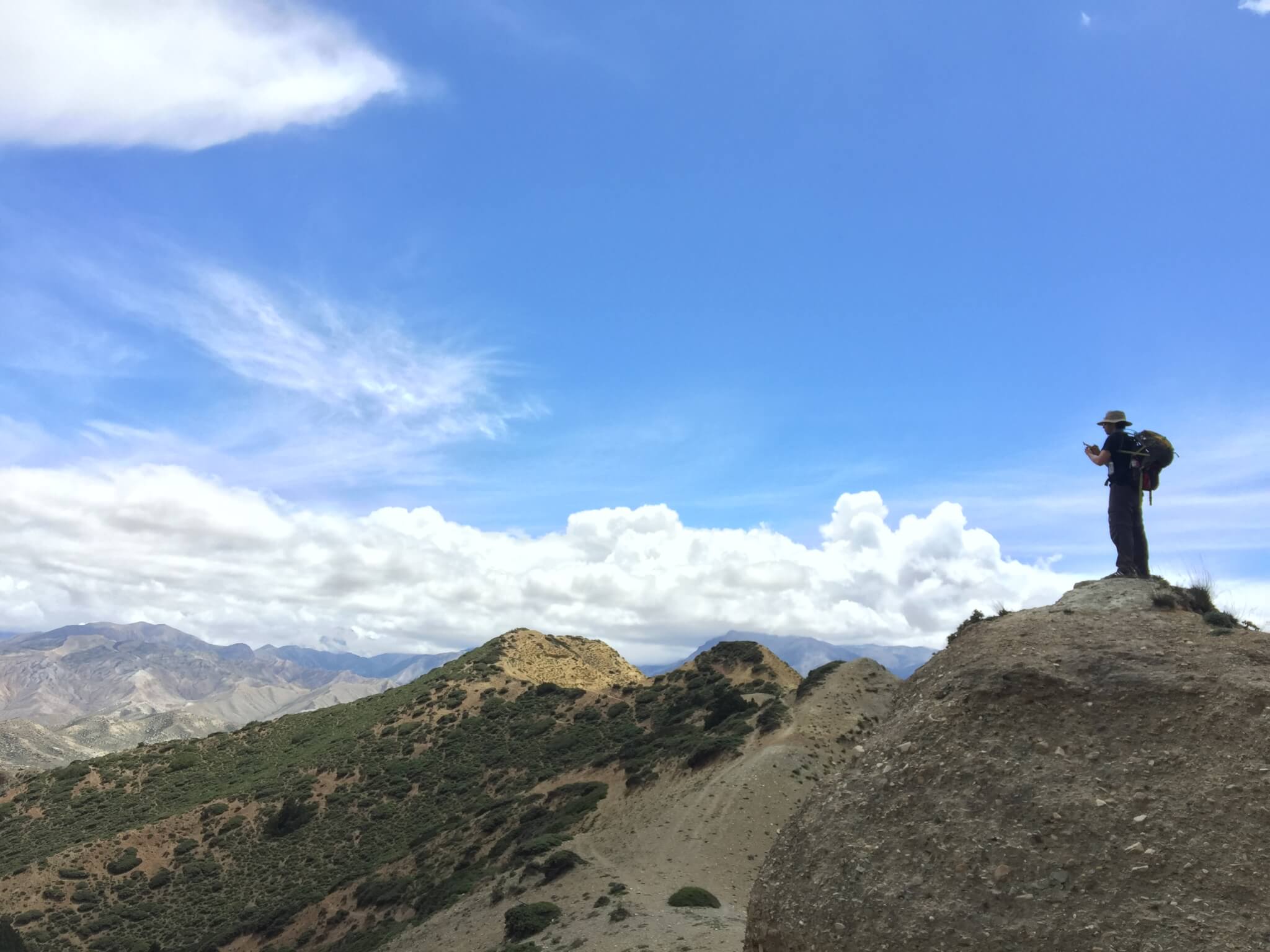
A big mistake I did was not wearing my trekking shoes. I had my running shoes on me thinking they were lighter and more comfortable, similarly to Pavel and Alex. But as their sole was flat, they were too slippery.
I was tired of feeling scared and my headache exacerbated because of my fear. I couldn’t even look at the mountains. And when they asked to take pictures, I could barely move nor hug Alex. I felt trapped.
One of the very few highlights of that day was that we found a lot rose hip bushes and I ate a lot of those sweet-sour orange and red fruit. I liked it and it reminded me of my childhood when my mum would brew them to make a cup of tea, especially when I was sick. And I was sick indeed.
I missed my kids, I imagined all sorts of negative outcomes if I fall and straight away when I caught myself doing that I pushed myself to think 5 positives. That improved my mood.
At some point, we reached the caves. I had no power to climb into them but Alex and Pavel went there to explore one of them. Meanwhile, myself and Tanzen decided to rest at the bottom of the mountain. And those 20-30 minutes were so sweet. I felt much better afterwards. I had my inner batteries recharged, we had some peanut butter with bread that we took with us from Samar. Tanzen had an apple that he carried with him from Kathmandu. And that apple with bread with peanut butter was delicious. We were laughing thinking that any even the most simple food tastes great when people are hungry.
After a short nap we headed towards Siangmochen our last but one stop, where I insisted we stop overnight. I dreaded to walk another 4 hours in the mountain after all those scary experiences in the morning. It was already 2pm and 4 hours meant we would be arriving after the sunset.
I used most of my tricks to persuade my team to stop in Sianmochen instead of Geling, as I feared I would be totally exhausted the following day. I had a headache, dizziness, tiredness, lack of appetite and had a bad night sleep. I pleaded for a mountain disease. On that one the answer was that we had to climb down the hill to stay at the lower latitude, to get a better acclimatization. I had no arguments. It was also safer. So we kept going.
For many times I swore it was my first and last trekking that I’ve done in my life. I’d be rather somewhere relaxing and not so stressed.
After 8 hours of trekking and 18 km of walking we finally arrived in Geling. It was a small town but felt like a paradise in a middle of a mountain range.

I had another cold shower, dressed warmly and went for our dinner.
In a dining room we met a group of Spaniards from the Catalan region who we found later were a big family. Two nice-looking parents and four similar age teenage kids. At first I thought some kids were friends but then they shared a secret with us: two boys were sons of the man and two girls were daughters of the woman. We had a lively chat with them and had our dinner. Although I wasn’t hungry I had to eat a garlic soup to increase the blood circulation and a bit of Dal Bat from Alex.
We went to bed early but with a headache.
DAY 7, 26th Aug, 2016
“Best Soup in the World”
We had a lazy start today as we wanted to rest and take it easy. I woke up many times but made myself fall asleep as didn’t want to disturb Alex, who had a terrible night of headache. I also had a headache but felt a little bit better than yesterday.
After a wake up, stretch and meditation, we went to have our breakfast which consisted of Tsampa & vegetable omelet, and a large pot of lemon and ginger tea.
Today we were planning to have an easier day. While walking on a rather flat surface of a mountain range we managed to talk just two of us: Alex and myself. And we discussed a lot of topics: from our family traditions and which country to go travelling next, to the future of coaching and our professional projects. That was the first highlight of our day. It made us feel so close together, as we were walking along a jeep road we had some space to be next to each other, with the sun above us and a wind behind us.

The way was beautiful, we reached a point where we crossed Himalayas and saw valleys of buckwheat and barley. They were so picturesque: full of colours and texture, we stopped to enjoy the sight.
On our way we saw the longest mani wall in Mustang. Mani means precious or pearl. People use a stone to write mantras and carve their wishes to leave on the wall for when they are gone.
For lunch we reached Gami. Old Tibetan women were so friendly and welcoming. They had an amazing garden and we thought it would be a good sign for a good cuisine.

And it was indeed. We ordered vegetable momo with soup, spicy potato and veggie curry. While waiting for the food to be cooked we had a good nap. After 40 minutes our food arrived. All was delicious and we were so happy to stopped by in this place. We took some pictures with the book and moved on. There we decided to search for a good garden to stay overnight and for dinner.
On our way to Tsarang we talked about films, about books on Buddhism, about differences between Tao, Hinduism and Buddhism. These were interesting discussions and all were possible as a lot of our trek was downhill and flat. Only two difficult bits were there today. And we took our time to go up, slowly and steadily. I kind of enjoyed today but still had a mild headache. Apparently it takes around 2 days to get accustomed to a higher latitude.
For dinner and our night stay we got to the Kailas guest-house in Tsarang. They gave us a room on a second floor and in the middle there was a big hole. Luckily we had our headlights to use to go to the toilet and downstairs.
Once we arrived the good news was that we had a hot shower. It was my first hot shower after 4 days. I was so excited, I took my clean clothes with me and went outside the building to enter an adjacent small hut with no light but there was this magic thing – gas heated shower! I loved the feeling and didn’t mind neither spiders nor darkness, it was just a bliss, to be able to clean yourself with a hot water whereas outside it was around 10C. The dress-up part was the hardest. As the floor was wet and there was no light I had to perform a bit of gymnastics to be able to dress without making my clean clothes wet. Plus there was no place to put clothes so I had to hang each piece on a nail in a wall. But I felt so grateful that I didn’t mind these nuances.
I got back to our room to find Alex doing exercises. I asked him if today was not enough in terms of exercise. But he explained that during the training different types of muscles get stretched and trained. He promised to himself to continue doing exercises so he did. And I joined him for a few stretches in the end.
I read, charged the phone: my main photo-taking device and we decided to go to for dinner.
We were served local plums which was the second highlight of the day. Juicy & sweet, these dark red small fruits.
It was a rather easy day. Today we walked 16 km and it took us less than 6 hours.

DAY 8, 27th Aug, 2016
“Tibetan Monastery”

The morning was early, at 6am we headed towards a Tsarang monastery & Gompa: Gompa once had the biggest library and a school. It was a male monastery and we arrived earlier than the service. Once we got inside the courtyard we heard a lot of voices coming from somewhere close. It was apparently a school class where kids were learning mantras and counts. I was curious to see what’s going on there and asked to get inside. They allowed us to get in to see how kids learn at a Tibetan school.
I sat next to one of the students and tried to tune in to what he was singing. It was sort of chanting or reading aloud some scripts
Afterwards I approached another corner where a nice smell of a Tibetan cuisine was coming from. An old Tibetan woman was using a long wooden tube and a pole to mash something inside there. After around 5 minutes she poured the content into a steel pot: it was a yellowish hot liquid.

I was so curious what was going on there and I asked if I could have a cup of tea. They welcomed me inside and I saw a group of monks having a breakfast. I was probably the most arrogant woman they have seen, asking something inside a male monastery but being Buddhist they agreed to accommodate my wish for a cup of tea.

I entered their kitchen where, surprisingly, there were a few young women, and more men-monks, eating Tibetan bread and traditional soup but for breakfast. I was offered a cup of Tibetan tea and bread as well. A woman saw me looking at their soup and explained that these monks are fasting and are allowed to eat only breakfast and lunch at 11:30. Afterwards no food until the following morning. For 45 days. That explained a healthy appetite.
We heard a bell ring and rushed to the beginning of the service. Outside the kitchen we saw monks putting on their red gowns and standing in a queue to get some water from another monk to sip & spit it on the ground. There were around 60 monks and it was an impressive gathering of devotees.
We got inside and were shown a way on our left to sit outside the main area and just observe the ceremony. The chanting started and the main monk used a speaker and his low pitch voice to fill the room with a special meditative energy.
During chanting other monks behind him looking towards the main statue at the front, bowed and spread themselves on the floor. It was a great physical morning exercise I thought.
At first they wore their dark red overalls, but then they took orange ones and put them on top of their red covers. They chanted and prayed with them for a bit and it looks gorgeous in a morning sun light coming from the top of the elevated part of the building.
Then monks stopped chanting for a bit and went to their side benches which had a small mattress underneath. They carefully folded their red & orange covers that they had just worn before and put red ones on their seats. Then they stood on them and some monks put an orange large gown on, which looked like a fur coat. It was rather chilly inside the monastery and I thought maybe it’s their overall coat to feel warmer. Later Pavel explained that it was a different outfit that they used to pray for their guru and higher spirits, according to their Buddhist tradition called Sakyapa.
After some chanting, one of the younger monks brought a tray with different musical instruments and gave them to other monks. There were Tibetan bells, praying long tubes called Dhumchen, metal disks called Tibetan cymbals, large shells and huge ritual drums that were used at the entrance making the chanting sound like a spiritual orchestra, a very unusual scene and something I didn’t expect to see as part of a monastic ceremony. But that was just a beginning.
Then came another young monk with some boxes and a large thermos. He gave us small cups and poured hot sweet milk tea and gave each a small cake. The same happened for monks in the centre who stopped chanting for a small snack.
As we were sitting and participating in this wonderful ceremony I couldn’t help thinking about its holisticity. They had so many different elements in a course of one hour: signing and praying, physical exercises, morning breakfast snack, musical orchestra and social connection aspect that unites them together. Beautiful.
When the service finished, most people left the building but we stayed as I felt quite emotional and really liked the energy in the room. We walked around the building looking at the details of the art, decoration, offerings they had laid out for spirits. The main monk was there and we approached him as he was explaining about the rare books that they have inside. He then told us about the very old chair that was holding that statue that everyone was facing. Apparently that was the only chair in the Sakya tradition left. Both that chair and the monastery itself were more than 800 years old.
Impressed by the grand scale of their tradition, I shared a couple of insights from a Christian tradition: how people pray and what they believe in. I also asked him if they followed Dalai Lama as their guru, as I saw his portrait inside the monastery. He answered that they have their own Guru who they follow but they respect Dalai Lama and other traditions. As we were leaving the building and saying words of thanks to him for a beautiful service, he invited us to see another area upstairs, which was used to pray for 4 hours a day and had important relics and art from Lamas.
As we entered a staircase we saw a mummified carcass of a snow leopard.

He told a story how they got this leopard inside. Many years ago the monastery had a big black dog who walked around the building protecting it. One night there was a lot of barking and monks went upstairs to see what’s going on. They saw a snow leopard fighting with their dog. They rushed to help and when they were out they saw a snow leopard dead on the ground. In one hour the dog was dead as well. So they mummified both carcasses and hanged them in a corridor to remember their battle.
Then we entered the sacred room. It was dark but nicely arranged. With Buddhist art on walls and a lot of small objects used for praying and offerings. Our host opened small wooden doors of a corner cupboard where we saw a range of various artistic objects that contained relicts of deceased lamas.

We were shown two very important paintings done with a blood of an important lama. A tradition says that when lama dies he has blood coming from one nostril and milk from the other. So they used that blood to paint the picture hundreds of years ago and it was still there.

In the middle of a room something was hidden behind the curtains and we were told that it was a statue of a Buddha that ladies cannot see. Hmmm, I was not that thrilled about that fact but expected it as part of their cultural tradition.
The monk showed us on his i-phone a ceremony that he did after meditating for 3 years, 3 months, 3 days 3 hours, 3 minutes and 3 seconds. It was done in front of a large crowd and looked rather different to anything I have seen before. Something of a trance state using a dance and movement to bless people who gathered around.

As we were leaving that place to let the monk pray for 4 hours, I felt emotional. There was something special and sweet in the air and if felt wonderful.
For the next few hours I felt a strange sense of euphoria, and my thoughts were mingled with recollection of that experience in the monastery.
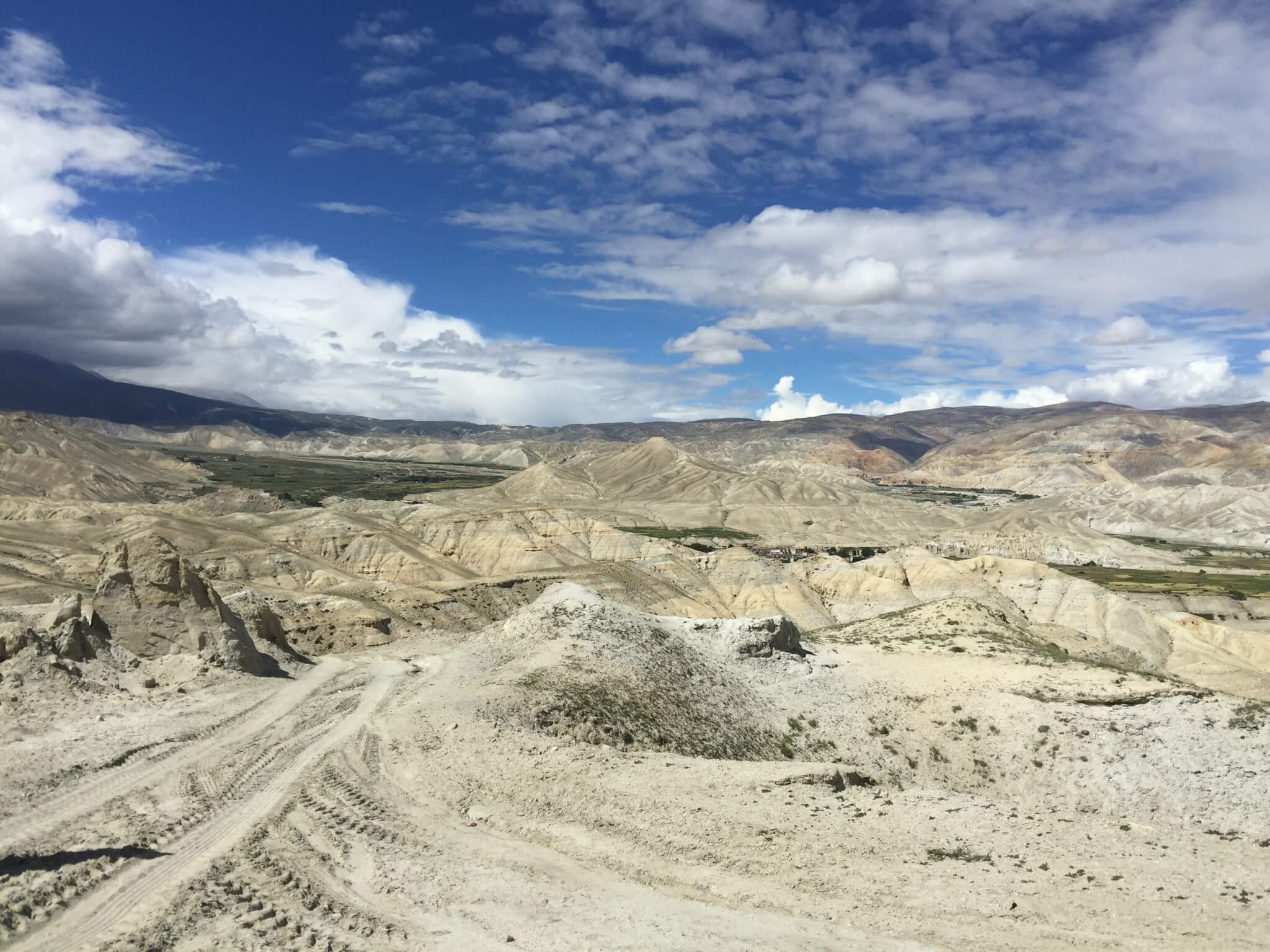
We went back to the guest-house, had breakfast and started our 4-hours journey to Lo Mantang.
Happily walking up and down the mountains we reached a beautiful scenery of the Secret Kingdom of Lo. It spread across a few kilometers between high mountain ranges of brown, grey and red sand formed into gigantic mountain piles.

I felt so happy standing on a 4000 meters high looking down into a secret valley that was prohibited to foreigners until mid of last century.
Nowadays with an average cost of 2500$/person one can travel to Upper Mustang but not cross the Chinese border. Some predict that in a few years the Upper Mustang area will be commercialised by Chinese so travellers cherish their time here as it may be the last time they see a different race in an environment that is like 100 years ago untouched by the Western civilisation.
When we arrived in Lo Mantang, we decided to check all guest-houses in the area to see which ones are the best, as we were planning to stay there for 2 nights. We saw a paper saying that Sangri-La had Wi-Fi. Now that was a big advantage over other places and we headed towards that guest-house situated at the outskirts of the village. Arrived we wanted to see if the food is nice as Wi-Fi didn’t really work loading only 20 bites per second. We couldn’t even send a message to the real world. No phones worked there of course. It’s been 4 days since we connected to the world and we wanted to check how our kids were doing.
It’s amazing how people live these days without neither phones nor internet.
Even the wifi place had that wifi to attract tourists but it didn’t actually work.
We didn’t enjoy food in the Sangri-la place and were still hungry after walking 16 km so we went to find another restaurant for dinner. Luckily we got into Lotus Holiday Inn, a rather new place with a good decoration inside. We thought they must have good food if they are good at decorating and looking after their place. And we were right. It was the best food we had in our trip to Mustang.

I had a mixed green salad and fried tuna rice, Pavel had potato fried momos, Alex – veggie burger.
We were given local wine (Rakshi) as a welcome drink. Despite the warnings of Pasha who said we shouldn’t drink alcohol at this latitude, we couldn’t resist local hospitality. Especially so as an Australian traveler said that last night they had a crazy party and it was all down to Rakshi which we must try. I heard some vibrant Indian music next door and went to explore. There in a kitchen I saw an old Tibetan guy dancing and I couldn’t help taking a small video of him, after which, he invited me to dance together with another guest who happened to be a Swiss student and a local Sherpa. It was great fun and the first time I so much enjoyed Tibetan culture laughing my heart out.
We used our headlights to get back to the guest-house as it was pitch-dark. The absence of a road and presence of a lot of dirt, made our way back a bit lengthy. We laughed what would it mean to find a bar or a club at this time of the night. When we arrived in Sangri-La, the owner, who happened to be a doctor of both Tibetan and European medicine, agreed to do a check-up the following morning. I was very curious to see what diagnose he would give to me. I also was curious about Tibetan herbs that he could prescribe.
With that thought I went to bed. Tomorrow we were booked for a day of horse-riding.
DAY 9, 28th Aug, 2016
“Horses and Meditative Caves”
A wake up was easy and late. We read, wrote, prepared ourselves and had a breakfast before a horse-man came to our guest-house. He had three horses with him. And there were four of us including him. He said he is going to be walking with us. Oh no, we had a different idea and didn’t want to be walked around like in a circus or like little children riding ponies. We wanted to gallop.
That the horseman one more hour to find a forth horse, which was his own. But apparently it was engaged somewhere in a field. While they were searching for a horse, I sat on a rock and watched local people. Women, mostly wearing traditional Tibetan dresses of dark grey colour, with a stripy apron made of yak wool and a similar style belt, had always a graceful look. Even very old ladies with no teeth or white hair, looked gracefully and they had curiosity and confidence written on their faces. A lot of small children either played or were being washed by their mothers. Generally Tibetan children seemed to be very quiet and observative, looking around from the back of their mothers, sitting in a fabric-made baby-sling. I was surprised that I haven’t met a single crying baby while being in Mustang. Mothers also looked calm and reserved. Some of them had shops in Lo Manthang, some – guest-houses or just cafés.
While people were passing us by I found a rose hip bush and was snacking from it like a local cow (now sure if cows can eat rose hip but that’s how I imagined it). I really liked the taste of it. The only complication was the seeds, which I had to spit on the side of the road. One local Tibetan woman was passing by and was curious why I was standing by the bush. When she saw me eating its fruits she was totally surprised. Apparently Tibetans don’t eat Rosehip. I frankly don’t understand why. It’s one of the best antioxidants and a source of Vitamin-C. I tried to explain it to her on my Anglo-Tibetan and she nodded and went on smiling. She must have thought I’m going to be sick after eating them.
But sick I was from something else. The day before I ate a tonne of local plums and probably something else that caused me to use anti-diarrhoea pills for the first time on this trip.
Not knowing how the trip is going to be with this new symptom of mine, especially on horses, I drank a lot of water and hoped it would be ok. And it was. During most of the day I was ok. Only by the evening when we got home I had to take another batch of two pills to make it a comfortable night.
But let me tell you how the day was with horses. I think it was the best day ever. The route we took for a few hours, was around Lo Manthang, just not reaching the Chinese border. We rode to meditation caves, where Tibetan monks used to pray for 10-15 years, sitting inside a wooden box in small caves. Rooms are all interconnected creating a feeling of a small city, which reminded me of a hidden underground city in Cappadocia,Turkey.
 It was a very special experience to sit there and feel the energy of centuries of meditation practice held by monks. I was so glad we got there.
It was a very special experience to sit there and feel the energy of centuries of meditation practice held by monks. I was so glad we got there.

After that we reached a couple of other monasteries and in-between we had our poorest lunch ever – packet noodles and nuts: bought in a local shop that had no real food for lunch. But because I was so hungry, I had no other choice.
It was all worth it. The horses were amazing! I rode Mombo, a white and black horse, similar to Alex’s Ko but a bit smaller and he was trying to follow Ko all the way through. But there was Pavel’s Mo, who also wanted to be number 2 and Mombo and Mo competed most of the way when Mombo was trying to overtake Mo but was not let in.
The highlight of the trip was galloping of Mombo and Ko. It was a feeling of freedom: my first experience of proper horse riding in nature and also gallop itself. At first I was scared that I would fall or something might happen but then I let it go and relaxed and the magic started happening. Mombo as though felt my feelings and galloped more than other horses. I stroked him every time that happened and he reacted to that by trying to do more of the same. It was amazing.

On our way back near a village called Namgial we saw yaks, sheep, goats, other horses, dogs and cats, cows and bulls and the most exotic was dzo, a mix of yak and buffalo.
In Nepal one can see a lot of different animals, in Pokhara, for example, there was once a rhino in the city center walking. In Kathmandu one can see an elephant being ridden. People are quite respectful of animals and try not to hurt or kill them.
By the end of the day, I had a nice feeling of euphoria when by the end of our ride I felt one with Mombo. We were part of the same rhythm and our movements synched. I loved those moments.
Happy and tired we got to the Sangri-La guest-house for a hot shower and change clothes to go for dinner in Lotus Holiday Inn.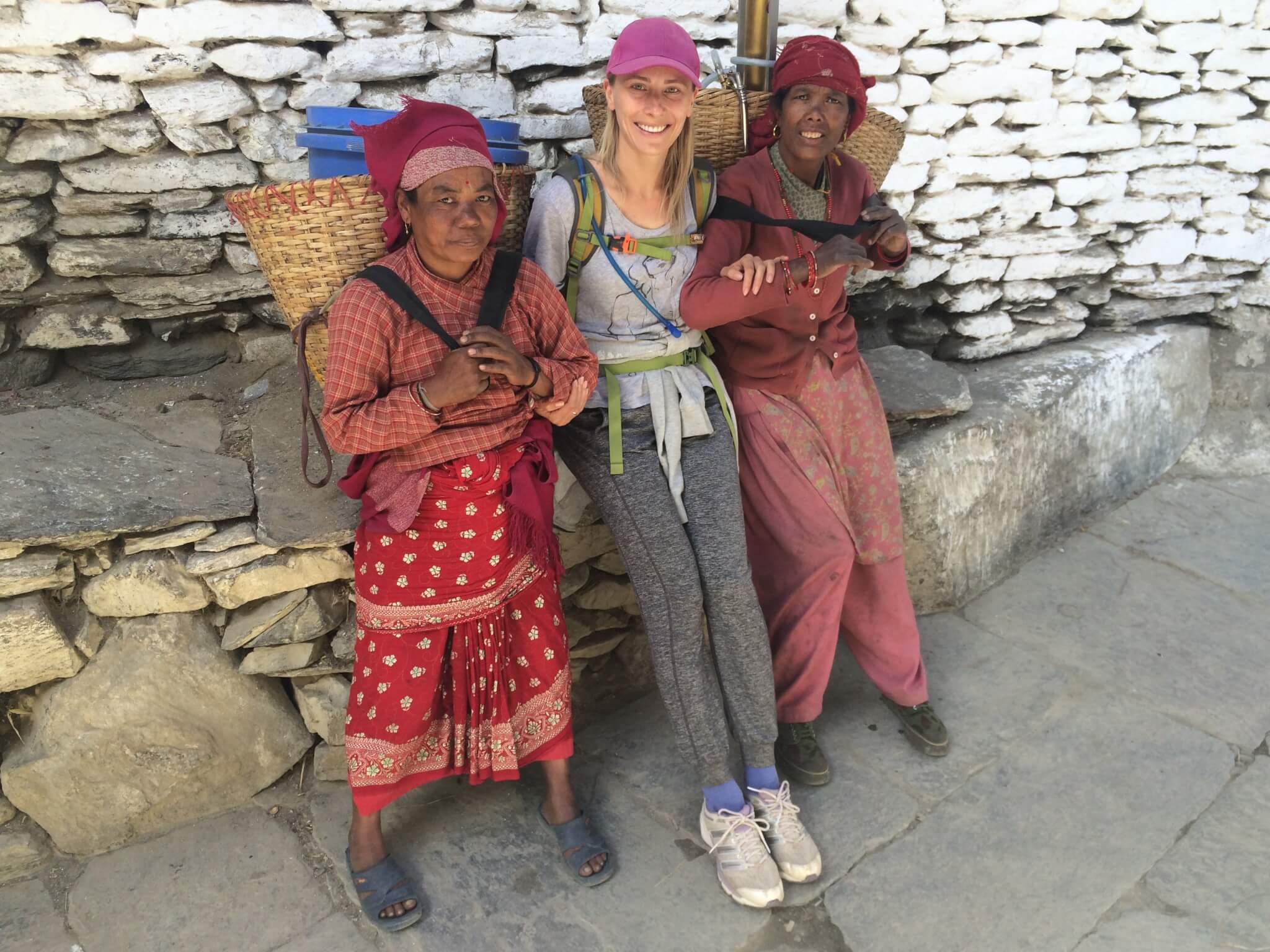
DAY 10, 29th Aug, 2016
“Born to Run”
Our day started rather early and ordered breakfast at 6:30. After packing and eating our simple breakfast consisting of tsampa and fried eggs (which I had 4!), we were set to go.
The doctor and his wife with their daughter Kazan put us khatas (Tibetan scarfs), we took some pictures and said good-bye.
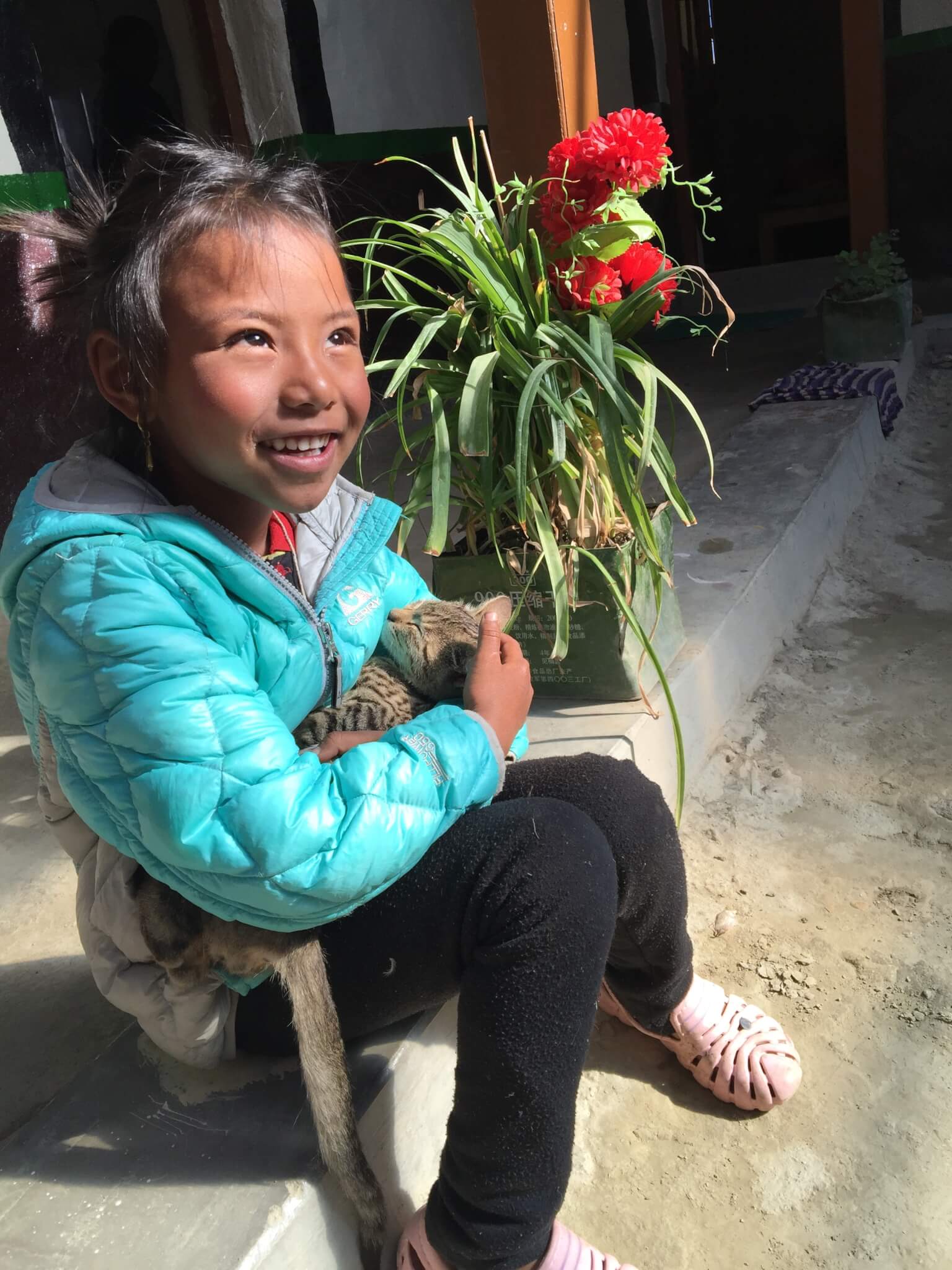
On our road across Tibetan plateau we met a horse with her son. They looked so peaceful and happy. Grooming each other, I couldn’t help approaching them a bit closer. When I was half a meter away, a baby-horse stamped his hoof. It was so cute, as though he was telling me not to approach them too close. I looked at him and grunted. He walked around to be behind his mum and then his mum also stumped her hoof. I realized it was time for me to go.

We continued walking. Our destination was Dakmar, 16 km south from Lo Manthang.
For the first time after 6 hours of trekking I had a feeling of elation. I wanted to jump and as we were walking downhill, I started running. And it felt amazing. It was such an unexpected feeling of joy. At that moment I understood why people go to mountains and why they trek. Until then I was questioning the very purpose of our expedition.

We arrived at the Tenzin guest-house which said there is a hot shower. We were so hungry that immediately asked for a menu. That was a strategic mistake. While waiting for the food to arrive, we unpacked and started reading our books. The food was lovely. Potato momos, veggie pakoda & veggie soup tasted wonderfully. But then we wanted to have a shower and realized there is neither hot nor cold shower. As it was raining outside and there was no other place nearby we had no other choice but to stay without a shower.
A couple who were running the place had a little daughter of one year of age. She was cute and both parents looked handsome. And good cooks as well!
That night we were joined by our new friends from Germany: Susanne and Sebo in a game of Speed Jungle. It was a lot of fun and at times heated.
Pavel told us many stories about the Everest and Annapurna peaks. Most of them were about the challenges that climbers had on their way up. He also shared a real story of Anatoliy Bukreev from Russia, one of the most respected climbers who died from an avalanche on Annapurna.
I didn’t know that Annapurna was one of the most difficult and one of the highest summits and no lay people are allowed to climb there as the death rate is around 40%.
After listening to stories and feeling inspired by climbers and their stories, we decided to add an additional route for the following day, to make it a bit special. Personally I feared it was going to cause me stress like at the beginning of our trek. But I was up for it.
DAY 11, 30th Aug, 2016
“The Longest 24 km”
 We woke up at 6:00 to have an early breakfast as our day was scheduled to be a long one. 23km long to be exact. We put Sultan sun cream, got enough supply of water that we could find in a guest-house, packed our bags, said goodbye to our new friends and headed towards the mountains.
We woke up at 6:00 to have an early breakfast as our day was scheduled to be a long one. 23km long to be exact. We put Sultan sun cream, got enough supply of water that we could find in a guest-house, packed our bags, said goodbye to our new friends and headed towards the mountains.

It was the most beautiful and the hardest trails we have done so far. We crossed at least 5 huge mountains going up and down, we saw beautiful gorges and rivers, snow tops and birds flying. The landscape was amazing. We met a French couple from Paris going to Lo Manthang and our Spanish friends on their way from Gami but apart from them it was all quiet and serene.

As we were passing Ghaite we decided to stop for a cup of tea. We were starving, to say the least. We had local bread and peanut butter with us until the end of the day. By the rate of our metabolism and physical activity plus the fact that we ate vegetarian cuisine, I felt a constant hunger. My hunger was probably the ultimate cause of anger. I knew that and wanted to eat something to make sure we have good energy among us.

As we entered the only guest-house we could find, we saw a young Tibetan women cutting fresh meat. We were almost vegan on this trip allowing ourselves to eat only eggs and a bit of milk in tea. But this encounter made us rethink our decisions. Apparently a goat was caught by a snow leopard overnight and part of the carcass was cleaned and prepared by the owners of the guest-house.
Instead of a small stop-over, the preparation of the meat took almost an hour. Instead of just sizzling it, it was fried in spices and then steamed for 40 minutes. As we were sitting there waiting, we were expecting a big plate of meat but it was just a 5cm one, like a small appetiser.
We asked for 4 boiled eggs for the trip as there was no other stops until Samar, and I knew I was going to get hungry.
The feeling of being minute in the midst of huge titans, sand-based mountains, is so precious. I believe it helps people reduce their egos and feel more humble. With no technology, phones or internet, with no access of helicopters to some of the most beautiful places on Earth.

I thought how important it is to be in nature and do some physical activity. Alex and myself decided to do other trails in Bhutan and Nepal, when we have a chance. Today was an amazing day and we couldn’t stop thinking how special this trek was.
It was the second time when I had a feeling of elation to run in the mountains. The grandeurs of Tibetan giants inspired me to just let it go and allow for the muscles to lead the way.
I felt like a bird flying in a wilderness.
We were planning to make little stops and by the end of the day get to Samar.
For dinner we ordered rosty spring rolls, green salad, t-momos with curry and sea buck throne juice. For tea – masala.
This night we played with the whole team: Alex, myself, Pavel, Sange and Tenzin. Lots of fun and high energy.
DAY 12, 31th Aug, 2016
“Gone With the Wind”
The day started with a heavy fog. We decided to wait until it would clear a bit but it didn’t. So we had to change the schedule and the route as there would be no reason to go up the mountains if we couldn’t see the view. We went along the route we came up with our destination was Kagbeni for the night. 15 km of walking with 1 hour for a lunch stop.
The wind was vicious. At times I was afraid I was going to be blown away. It was so strong that even my weight with the rucksack was not heavy enough to feel grounded. I walked shaking and only high altitude glasses and a buff helped me with a balance.

For lunch we stopped at Tambe, the same village we stopped on the way to Lo Manthang, and of course I had Dal Bhat.
After a short stop we continued our expedition until Kagbeni Annapurna hotel, where we hoped to get wifi, hot showers and electricity to charge our phones.
Kali Gandaki was large and grey, like a carpet with strings of fabrics, it was flowing all our way to the city of Kagbeni, a large merchant town: one of the nicest ones in the area, with local culture and traditions. About the local culture we found from meeting a nice-looking researcher from California, who stayed in our hotel and did a study on Tibetan identity and how it’s changing with time and European influences.
Apparently villagers who would profit from the road construction by getting more tourists, medicine and produce, were more positive about the changes and were eager to engage with foreigners. Others were not so keen as they thought of the road construction as an intrusion into their life and bringing more dust and taking trekkers away from their villages by means of jeeps and buses.
That night it was an epic game of Jungle Speed with our Spanish friends who happened to stay in the same Annapurna hotel with us. We had lots of fun and the atmosphere was light and giggly.

I hoped the following day would be just a ‘walk in a park’ as we didn’t plan to do a long trek anymore.
DAY 13, 1st Sept, 2016
“Landslides”
13th day was the hardest day for me. And maybe for the whole of my life. I faced my greatest fear together with another fear. It was a conglomerate of fears and I wasn’t sure how I was going to end the day.
Instead of waiting in a nice guest-house, we decided to trek to Muhtinad, a popular village in the South from Kagbeni. On a way we wanted to stop at Jarcot for lunch and then come back. A short 12km walk.
The only problem was that the road that we were supposed to trek on was closed and instead of following a jeep road we went along the river, which was rather fun at first.
Then we reached a point where there was no way to cross it without getting properly wet. But Pasha saw a path up the mountain. We went a long thinking he knew what he was doing. But in reality he didn’t.
The path lead to a narrow and steep climb above the rocks and suddenly I got really scared. I saw them climbing the path and disappearing around a big rock. I stood there waiting. I hoped the path would get easier but it only got more difficult. At some point it was around 70 degrees inclination and I was scared I would slip onto rocks that were plenty in the river.
I shouted and cried and Alex came down to help. I realized I couldn’t move as I was in shock. Every step was a struggle. I wanted to disappear. I wanted to get back. I wanted to go home. I swore I would never go back to mountains again.
With Alex’s help I managed to get up and walk another 10 meters to a point where there was a big rock that I could sit on. My legs were trembling, my body was shivering and I burst into tears.
After a minute a local man came up the same path shouting that we shouldn’t go up there as it was too dangerous. My concerns doubled and my trust in our guide went down the hill.
Pasha tried to explain to that man that there was a path but a man got angry and said we could do whatever we wanted but he told us that it was too dangerous to climb. Little did he know that it was my first trekking experience and I was scared to death.
He pointed to an alternative route parallel to the river, which we took and I was walking slowly and holding to every opportunity I could find. Every rock I could catch to balance. In the end Alex took my hand and helped me move forward.
Finally we reached a jeep road and took it back to Kagbeni where we found a jeep to go to Mukhtinad.

The road was bumpy and slightly uncomfortable but with my sore fingers & toes it was our best choice.

When we arrived in Mukhtinad we went to a very special pilgrimage place for many Hindu people. It is a place where 108 sources of water are known to mix from mountains and people from around the world come to get a blessing and wash in this water. One who bathes in all 108 sources cleans their karma. It is of high importance for Indians because of Kali Gandaki river which has a special connection with Kali, which is one of the important Hindu goddesses of distruction and as the river takes its roots in Nepal and every year thousands of pilgrims walk for hundreds of miles to Mukhtinad. Not only the water but this place also has a holy fire that purifies from bad karma.

After visiting Mukhtinad we went to Jarkot where there is one of the oldest fortresses and medical centers inside a monastery. But it was closed. So we headed back. But instead of a jeep we agreed we would run. With our backpacks. And I did. Almost 10 km run.

Arrived we had a dinner but it wasn’t nice as the chef was away in Jomsom.
DAY 14, 2nd Sept, 2016
“Scariest Jeep Road”
We started the day with a treat: fish for breakfast. After wanting to eat fish the night before but couldn’t because the chef was away, we ordered it straight away when we got a chance to do so. And it was delicious. A Tilicho lake fish grilled with a mustard sauce and seasonal vegetables.
Having fueled our bodies with energy, we were heading towards a region of Tatapani: according to our guide, the best hot springs in Nepal. Our expectations were high as instead of a 15 min flight, we had to take jeeps to reach hot springs.

Driving different jeeps were kind of a mandatory thing as the road was divided into syndicates and every syndicate had their own jeep which a traveler would have to pay for. That was one of the few incomes from tourism left after a new road was built and jeeps started taking tourists to different destinations instead of them trekking on foot and staying in guest-houses and restaurants.
So we found a jeep driver who agreed to take us towards Tatapani but apparently there was a big landslide that covered the road and jeeps couldn’t go through. So we would have to walk from that point onwards. The sun was shining and it was a nice morning. We were happy to follow this adventure excited about the hot springs that we are going to visit soon.
But the road was terrible. Not only full of rivers, mud & huge puddles, but it went up and down, on rocks and branches. At times I felt we were going to stay like that forever. I was afraid we would crash, slide down, get stuck in mud or a car would break down. And we did get stuck in mud.
At some point where there was more mud than a car can manage, it just got stuck and stopped moving. We had to get out of the car and walk, until the driver would manage to move forward. And he did! We were ecstatic. As otherwise we would have to walk in mud and stones for another 3 days and miss our flights to Europe!
Alex was taking videos and pictures and he obviously enjoyed the ‘Top Gear’ ride although I considered it was dangerous.

We arrived in Marpha, a small and traditional village, just South from Jomsom. We wanted to just have a stop as apparently there was only one thing to see – a local monastery. Which was closed. Walking inside its cute little streets on our way back I noticed a sign: Rosehip Learning Center. And I was curious.

We approached it and saw a nice-looking library and a playground for children inside a wooden-built old building. It turned out to be a Waldorf-like educational center for children which was part of the Marpha NGO. We were greeted by a good-looking lady who was a director of the center called Jessica. She explained their mission, programmes, way of life and asked about our jobs and intention in Nepal. After we got to know each other a bit, she asked if I would be willing to help them as they needed mentorship and family therapy from a psychologist. Of course I would. We exchanged contacts and I felt elated. The whole trip with landslides and issues was worth it because of this encounter.

We arrived in Tattapani after changing jeeps & walking around the landslide area, to find out that there was another landslide happened just a day ago near us down the road. That meant we couldn’t reach Pokhara by road directly. We would have to walk another half a day and after a landslide get a bus to Pokhara.
After a quick change of clothes we went to the hot springs of Tatapani, with high expectations as it was the reason why we came to that place. And it was one bath with hot water where people bathed like in a Jacuzzi. It was rainy and the experience on its own was nice and warming. The water was hot. We saw two French girls inside the pool and started talking. They also wanted to travel to Pokhara the following morning and we hoped the weather would improve and we could get through.
It took us just half an hour to ‘enjoy’ the place and we were ready to go back. I was a little bit disappointed as it took us 6 hours to get to that place and there was just a concrete-made bath with hot water. Oh well, one learns. We definitely learnt a lot from this trip and knew what we wanted to change next time we trek. We would explore the trekking paths better and choose a better route.
After discussing our options for the next day and having veggie moussaka and veggie lasagna we went to sleep.
We had a prayer there would be no rain overnight so we could get down to Pokhara ok.
DAY 15, 3nd Sept, 2016
“Accident on the Road”
We woke up in the middle of the night from a rainstorm. We managed to fall asleep to be woken up by a plug which was on fire.
Having a bad start of the day, we quickly packed and checked the weather forecast for the next couple of days: rain, rain, rain going down and dry going up. The decision was easy. We decided to get back to Jomsom and take a flight from their to Pokhara. A 15 minute flight instead of 15 hour journey back. We booked the tickets for Alex, Pavel, myself and Emmanuel, the Spanish guy. At least that was the least riskiest option. Going down towards the landslide meant we had to walk for hours and not knowing the road to then somehow find a bus. And buses in that part of the world is an experience on it’s own.
Having ordered 6 boiled eggs and 6 breads, plus we had a few kilos of apples that we bought in Jomsom and carried with us down. In the same place in the morning we met a Spanish guy who had a problem with his knee. He slipped and damaged a meniscus. He also wanted to go down to Pokhara but had troubles moving.
When we got outside of the hostel, we found a few empty busses as well as a taxi driver. He could only take 4 people to a place that is in the middle of the landslide and where we were. That was not an option as we had no clue how to get further from there.
Then an Austrian-Tibetan traveler came around asking if we are going down to Pokhara. We explained that we are going back to Jomsom. Then two French girls appeared who we had met the night before in a thermal spa.
Now we had a group of 6 foreigners who all wanted to get to Pokhara. But because we decided to go up to Jomsom they also wanted to join us. Meanwhile we realized that we couldn’t book flights for Sange and Tenzin as they were Nepalese and for Nepalese people one can only buy tickets at the book office in Jomsom, and not online. What a strange rule!
So unable to book them flights Pavel decided to send them down and we would go up to catch a flight. Feeling sad, Sange and Tenzin said good-bye and set of walking into the unknown.
We took a bus to the bridge, crossed it and found a jeep station on the other side of the river.
The problem was that jeeps were already booked and there was no other jeep available. After waiting for one more hour we managed to get a jeep that could take us to one of the next villages. And there we had to take another jeep.
With no options we had to accept his offer and off we went. It was a bumpy road but we were happy it was moving. We had two girls from France with us and a Spanish guy with a damaged knee.
The driver had an Indian jeep which was a powerful beast on those muddy and stony roads. I had lots of hope for it.
It took us around 30 minutes before we approached a river crossing which was blocked by a bus stuck in water. Behind it was another bus and some people trying to get that bus out of water and move. Without success.
There was no other way to go around. There is only one road in mountains in Nepal. And it’s not possible to cross the mountains either in that part. They were cliffs covered with trees. So we had only one option – to wait. To wait for someone to come and rescue that bus, so we can move ahead.

Looking like a circus, people gathered around the scene to watch what would happen. Including us. Someone called someone to send a big truck to pull the thing out. So we waited.
 Finally the truck came. The rescue operation was amusing to see as the truck was trying to pull the bus out very quickly and not succeeding. After a few attempts, it managed to pull slowly and move the bus backwards. Not without a damage to the back side of it because of the pull, but at least the road was unblocked and we could move ahead.
Finally the truck came. The rescue operation was amusing to see as the truck was trying to pull the bus out very quickly and not succeeding. After a few attempts, it managed to pull slowly and move the bus backwards. Not without a damage to the back side of it because of the pull, but at least the road was unblocked and we could move ahead.
Cheering ourselves up after the rescue operation we approached a small village where our driver stopped. We had to find another way to continue. Even after we offered a driver an additional amount he refused saying that all jeeps have GPS trackers and are not allowed to cross another syndicate’s part of the road.
The problem was that there were no jeeps available. Of course, with such weather and everything that comes with it.

Pavel went up the road to find what we could do. While we went to the local ticket office, which was closed. We saw a dark skinned man appeared from nowhere and opened the ticket office. With his broken English he explained that there were no jeeps available but he could ask if a driver would be able to come from the village.
Yes please! We were so amazed that he even asked us if we wanted that option. Of course we did!
10-15 minutes later a driver appeared with a jeep. We agreed on the price and got all inside the biggest jeep we had ever driven. It looked like being specially designed for those roads. Although not very comfortable inside and with a hard suspension, I felt it could drive the roads. That was the most important at that point. In a minute Pavel also joined us and we continued our journey back to Jomsom.
By 4pm we arrived in the place where we started our journey to the Upper Mustang. A city of Jomsom. After trying to check into the same guest-house we were told it was full and instead we went to the New Marcopolo hotel, which was just 50 meters down the road.

It was what we needed: shower, bed and food.
As we ordered food after a long journey, we saw a limping man. A few questions and we found out that it was Manuel, one of the Spanish cyclists who fell off a bike while in mountains and broke his knee and a hand. He needed hospitalization and was on the phone with his insurance company who agreed for him to be rescued by a helicopter as soon as possible. That meant the following morning.
The weather in Jomsom is not predictable, as in most mountains. Planes can fly in and out of the city only when there are right weather conditions: open sky, not too much wind and visibility until the destination. In case of Manuel, he needed to come to Kathmandu in order to reach a Grandi hospital. The best private clinic in the country. The only problem was that the weather was not permitting for a helicopter to fly from Pokhara to Jomsom to pick him up. And there are no other towns around to send helicopters for him. So he had to wait.
We tried to create a cheerful atmosphere for him by putting some nice music, giving some ideas for relaxation but despite pain-killers the pain was unbearable for him. And he couldn’t stay still. With a broken leg he still moved around and tried to speak to his family, girlfriend and insurance guys to put his mind away from his misery of waiting.
While this was happening and looking at our possibilities, we started worrying as well. If the weather was bad the following two days, we wouldn’t be able to fly to Pokhara and hence to Kathmandu. That would mean changing our tickets home as we were supposed to fly out in two days on Monday. In my case it would mean upgrading to business class or buying new tickets. In both cases – spending a couple of thousands dollars more, as there were no last minutes tickets available from Kathmandu to Moscow. And I needed to go pick up kids before heading home to the UK.
Our adventure continued but decided to relax and enjoy a moment that was available for us with our lively company: a Greek, two Russians, two French and two Spanish. We decided to play Jungle Speed and had lots of fun.
After a light dinner we went to bed, hoping the following day was going to be a good one to fly back.
DAY 16, 4th Sept, 2016
“Waiting for a Helicopter”
We woke up at 5:30 to pack and check if a flight would be leaving at 6:45. As soon as we got outside we realized we had little chance for a flight: it was windy and cloudy.
We needed a plan B. We tried to see if other air companies were flying but there were none. We had to wait. Even Manuel’s helicopter couldn’t fly from Pokhara to Jomsom.
But what if it could fly in the afternoon to pick him up? Would there be a possibility to fly out with him? Alex phoned the helicopter company and confirmed there would be one potential seat to fly out. As from the whole team I had the earliest plane booked, we decided that when the heli comes to pick Manuel, I would fly with him to Kathmandu as his support friend.
All was good in theory but in practice there was a lot of rain and neither planes nor helicopters were flying.
We had our breakfast, I read a bit of a book and went to the airport again to check if there was a flight from Pokhara to Jomsom. But there was none. Due to little visibility in Jomsom.
We waited more. We were worried about the weather condition. The forecast was ‘rain’ for the next 30 days in Pokhara. What does that mean? I wondered. Would we have to stay the whole month if it rained and was cloudy? And what about poor Manuel and his broken knee and hand?
But the reality was that our destiny to fly was totally depending on the weather.
It was the first time in my life I felt helpless and didn’t know what to do. I prayed we could fly out tomorrow. It was our last day before we had to change the whole shebang with our flights: Jomsom – Pokhara – Kathmandu – Abu Dhabi – Moscow – Krasnoyarsk. And then Krasnoyarsk – Moscow – London – Nottingham. Quite a journey back.
The evening got better as Pavel brought two new friends from Moscow who he met on the way to a small Gompa: Natalia and Rainbow. Both lived in India, Bali and Nepal in the last few years and they looked like happy hippies: spiritual, worriless and quirky. Having a cup of ginger-lemon-honey tea together we had a long chat about the wisdom of the universe, Buddhism and Hinduism, beauties of living in different parts of the world, love and peace and much more. All while Alex, Manuel, Funny and Carole played a few hours of cards. The atmosphere in New MarcoPolo was gay and joyful. Noone cared about the flying out during those hours.

The last interesting thing of the day was my visit to a Tibetan doctor.
Alex somehow met one outside of our hotel and mentioned that I had a cough. The doctor offered his help and we went to see him in his family residence just around the corner.
I was surprised to find an office full of bottles of herbs and herbal pills hand-made by the doctor’s family. Apparently he was the 7th generation doctor and every doctor in his family was a retreater. That meant they had to be 3 years, 3 months and 3 days in a dark cave meditating in silence for all that time. Impressive. He had pictures of his forefathers ordinated with lama status and certificates of excellence from the government of Nepal. Apparently Seione was coming from one of the oldest herbalist doctor family in Asia. His brother and sister were working in New York in America, whereas Seione preferred to stay at home helping people.

He quickly diagnosed myself using a light torch to see my eyes and tongue, his hands to check my pulse. He confirmed I was healthy with only little problem with coughing. He prescribed me anti-cough herbs suggested to be careful with sweets and eggs when travelling and changing climate or seasons.
Happy with my experience of visiting a Tibetan doctor, I returned back to Marcopolo, had a light dinner (apart from a very heavy snicker’s wrapped in a pancake, apparently a local delicacy) and went for hopefully last night in Jomsom.
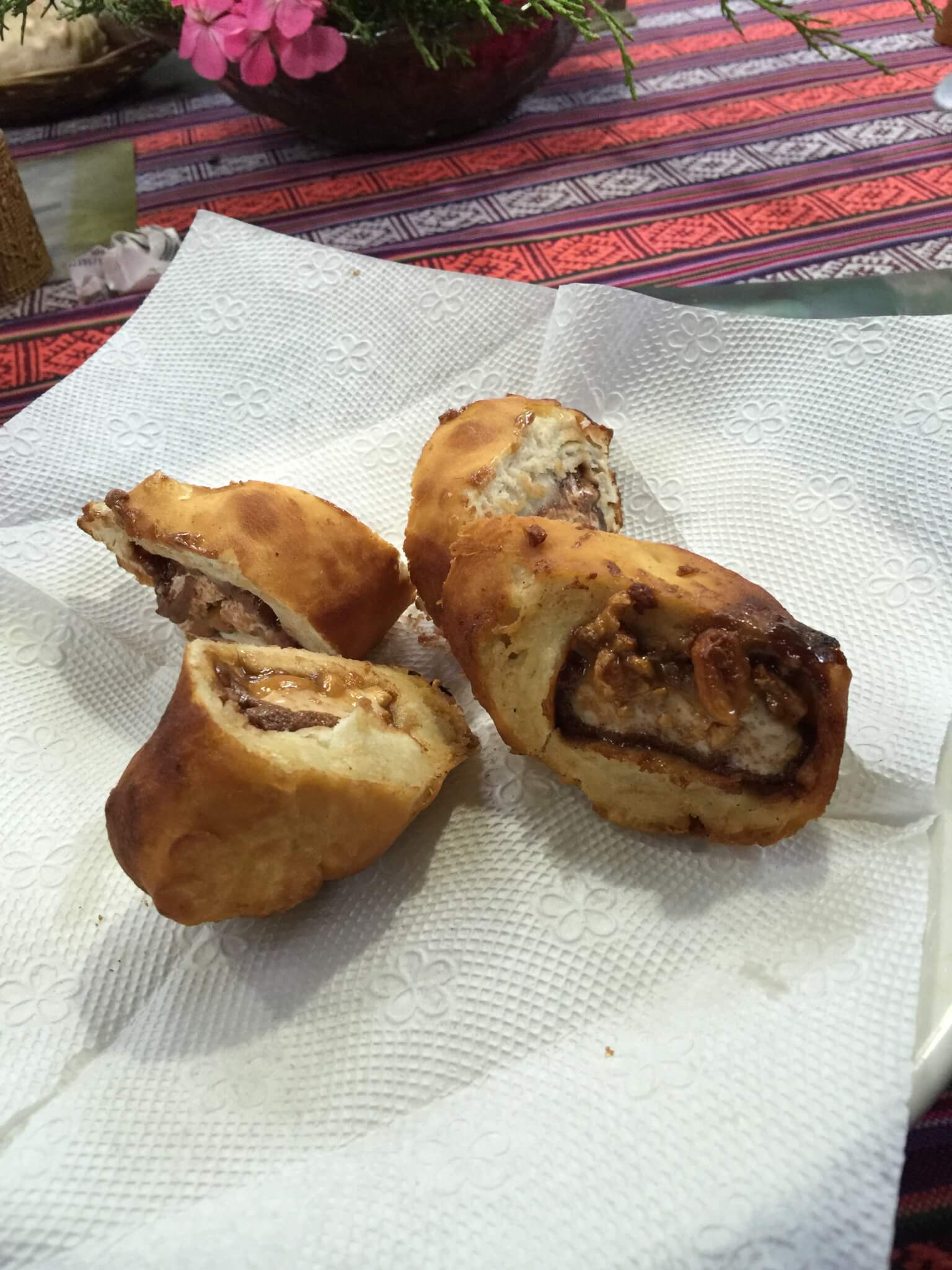
I prayed it would be sunny tomorrow morning.
DAY 17, 5th Sept, 2016
“Flying Back Home”
My prayers were heard. The morning was gorgeous.
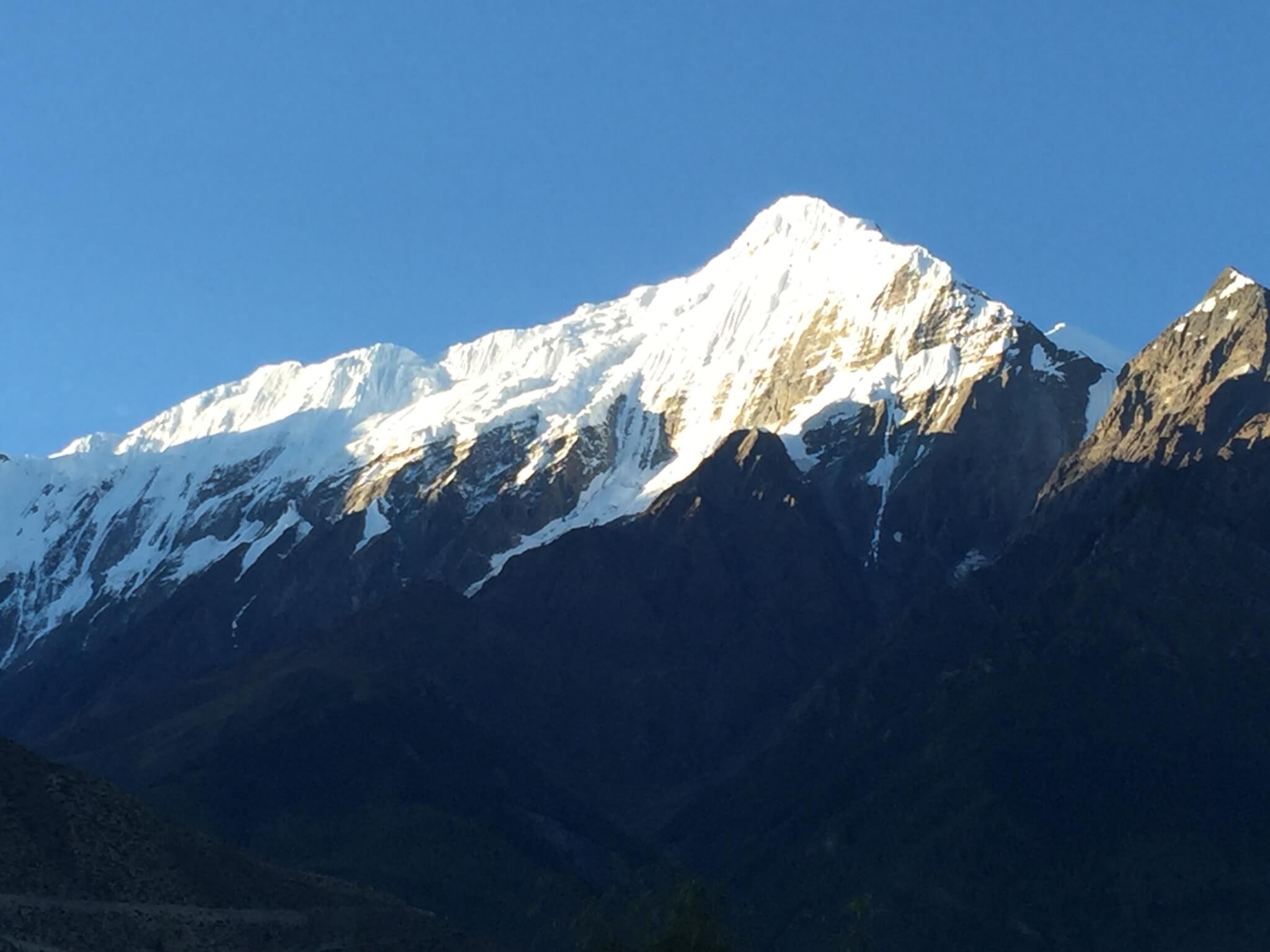
We could see the snow peaks of the mountains and we knew we could fly. But how? We had to decide if we waited for our plane or take a helicopter ride, which was three times more expensive if we divided the whole cost by six people.
Two options we had: wait for a flight (potentially until 11am or later) but risk a weather changing. Or pay more and fly with the second round of the helicopter that would pick up Manuel.
The common agreement was to take no risks and pay more for a heli. That would mean the first helicopter ride for most of our team. Only myself and Alex had previous experiences of flying with a heli. And we colorfully described it to everyone. Excited about such an opportunity, all were ready.
But there was no helicopter.
Manuel phoned the insurance company who were surprised as well. He then phoned the doctor who was on guard in Pokhara who contacted the pilot. Apparently the pilot was sleeping.
That’s Nepal for you. Two days being stuck in mud and landslides and coming back to Jomsom. One day stuck because of the weather condition. And finally when the sky is blue and sun is shining, the pilot is sleeping.
What could we do? When the pilot was finally awake in one hour we heard a familiar noise in the airport when a helicopter approached the runway.
Manuel and myself, helping him, went outside. We were met by a Nepalese doctor, an American lady who we thought was a paramedic and a pilot who was a tall, large, beard American, in jeans, t-shirt and a baseball cap.
Alex helped with the bags and we realized there was one more seat inside a helicopter that could accommodate six people in total.
 We kindly asked if Alex could join us and he was allowed. Yuppy!
We kindly asked if Alex could join us and he was allowed. Yuppy!

After getting to know the pilot he happened to be a nice guy. The lady was not a paramedic but his visiting girlfriend.

The flight was amazing. We crossed the Himalayas, seeing Annapurna peaks and Dhaulagiri, the villages we crossed on the way to Tatapani, the roads looked like tiny dark strings around the mountain along the riverside. But we knew they were not just little roads, they were muddy dangerous paths that no cars would be willing to drive on. Some called it ‘a road from hell’.

Arriving to Pokhara was a triumph. It was a smooth landing with a cheerful welcome by the local crew. As soon as we got out, the pilot got a new team in. This time it was a Finish and German ladies, who for three days tried to fly to Jomsom to go to the Upper Mustang but couldn’t. So they took a similar strategy to ours.
The pilot went back to Jomsom to pick our friends while we stayed waiting for him to come back and take Manuel to Kathmandu. Us included.

The wait was not long. Only 50 minutes and we saw the red helicopter coming back. Our friends got finally to Pokhara, and they could take a flight to Kathmandu, as there were many flights per day with different companies.
We took our bags, approached the red saver and… we realised that we were missing Alex’s big backpack. Where could be lose it? After phonecalls back to Jomsom, the crew found it. They forgot to load it onto the vehicle.
Now we had to wait for it to be loaded to a plane. The good thing is that it’s one of the shortest plane rides – 15 minutes. And we just stayed in a shade thinking how we would all return back to Kathmandu to catch our flights back home. I was longing to get out of that place.
Finally the plane arrived and a local Nepali member of the crew brought the bag. All loaded, we got inside, said good-bye to our new friends and headed towards Kathmandu.
This time it was an even more epic landing – on top of the 14-story building in a middle of the city. Around 20 people in white gowns gathered on top of the roof meeting us, many taking pictures of the helicopter. The unloading was quick and professional. We got the bags and followed Manuel’s doctors, to the emergency section on -1.
Luckily, Manuel’s health was not at risk and he would avoid an operation as the hand was not totally broken and knee had a light infection. Antibiotics and care of the top-notch hospital was what he was needed.
We served our mission and could now go home.
But before we went to the airport, we had to get our bags from the Shambaling hotel, get some food and little presents for our families. So we decided to spend a few hours in local markets shopping for local music instruments and traditional spices.

It was a total fun. The most vibrant city I have been. We both fell in love with Kathmandu.

Walking outside of a beaten and non-touristic path, we saw some amazing pieces of architecture, local creativity and advertisements.

What to say?
In this short factual blog it’s hard to convey emotions and impressions we got from this trip.
It was one of the most impactful, real, adventurous and mysterious trips we have ever done.
I’m so glad we ventured upon it. But if you ever decide to do one, remember to get ready to have an open mind, be flexible, have good medicine with you, a good guide, carefully choose your route and avoid risk of the roads. Allow some flexibility of the way back and do the most important things first. Leave the rest to that chance of weather. It’s never predictable so you may get stuck in a middle of nowhere. Just get ready for it in Nepal.
The way back was a piece of cake compared to the whole trip. Alex managed to upgrade us to business class on the way from Kathmandu and we flew in style. All on time, I caught a Moscow-Krasnoyarsk flight arriving safe and sound.
Happy to be back home.
